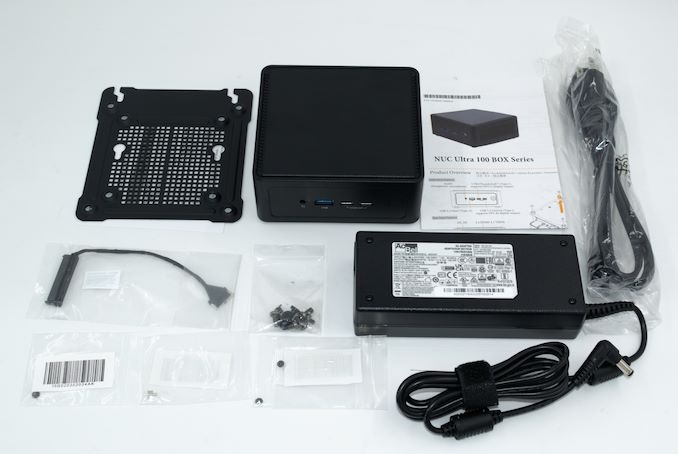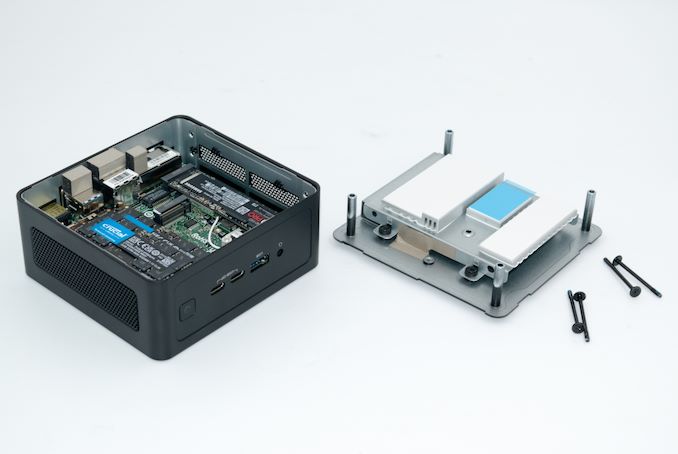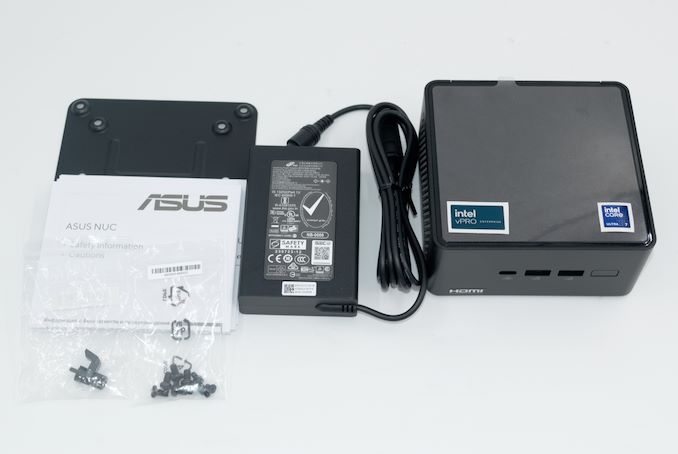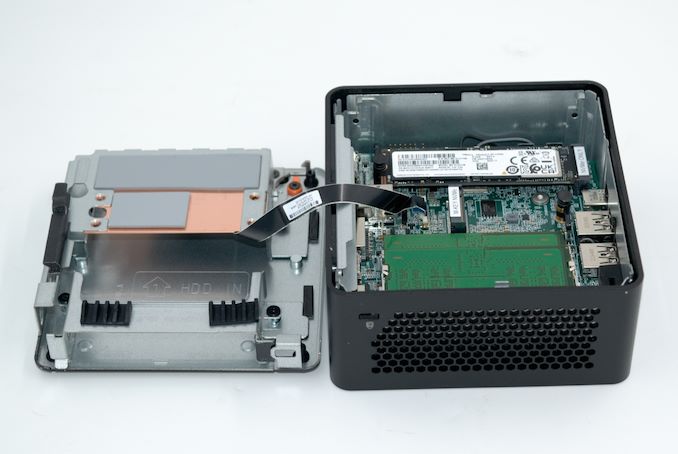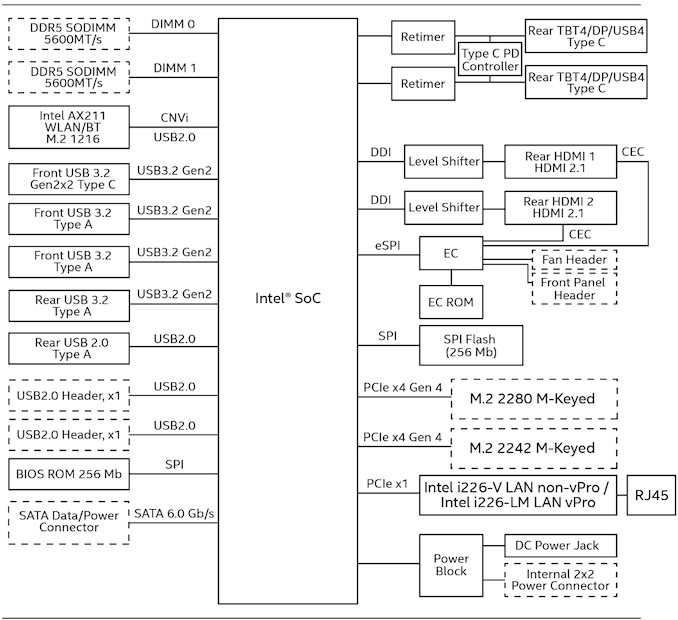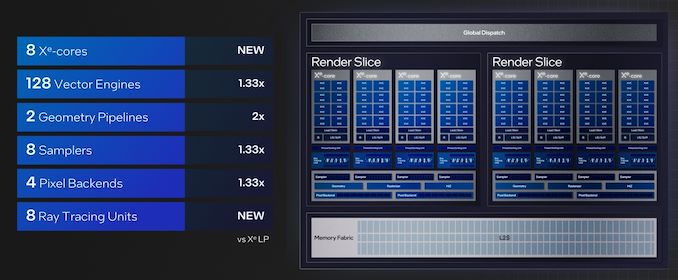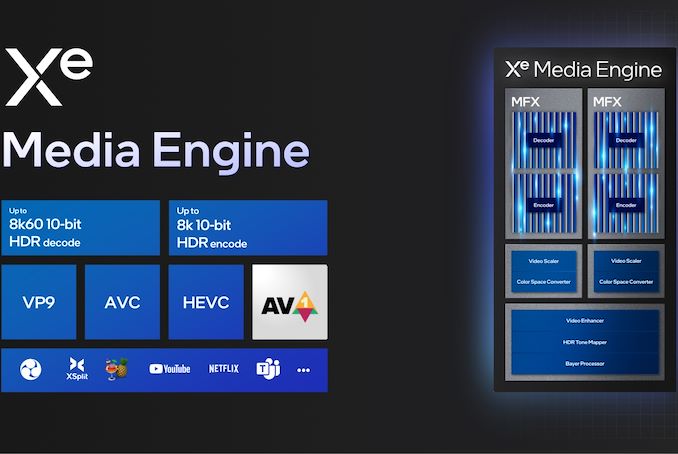Intel’s Meteor Lake series of processors has had a drawn-out launch since its details were officially revealed in September 2023. The series marks Intel’s foray into the consumer market with a tile-based chiplet configuration held together with Foveros packaging. Similar to Tiger Lake, the focus of Meteor Lake has primarily been on the mobile market – ultraportables and notebooks. However, this has not prevented Intel and its partners from introducing it as a follow-up to Raptor Lake-P and Raptor Lake-H in the SFF / UCFF desktop market.
ASRock Industrial has consistently been the first to market with ultra-compact form-factor motherboards and mini-PCs, with product announcements often coinciding with Intel’s launch of its latest and greatest mobile processors. Meteor Lake has not been any different, with the NUC(S) Ultra 100 BOX series launching towards the end of Q4 2023. In the meanwhile, Intel’s NUC business was taken over by ASUS. ASUS’s first major product announcement after the acquisition came in the form of the Meteor Lake-based Revel Canyon NUCs at the 2024 CES.
The flagship NUC Ultra 100 BOX system is the NUC BOX-155H based on the Intel Core Ultra 7 155H. The Revel Canyon NUC lineup includes a model based on the Core Ultra 7 165H with vPro capabilities, with its claim to fame being the ability to hit 5 GHz on the performance cores. This review takes a detailed look at the features and performance profile of the ASRock Industrial NUC BOX-155H and the ASUS NUC14RVHv7. The analysis also helps in establishing the potential and benefits of Meteor Lake for the UCFF desktop market over its predecessors and the competition.
The last decade has seen significant strides in processor performance as well as power efficiency. Coupled with advancements in thermal solutions, we have seen compact systems with low-power SoCs becoming capable of replacing bulky desktops for many use-cases. This trend gained mainstream attention with Intel’s introduction of the ultra-compact form-factor (4in. x 4in.) NUC in the early 2010s.
The 4×4 form-factor continues to hold sway even today, as evidenced by the variety of UCFF systems introduced by multiple vendors every year. Both the ASRock Industrial NUC BOX-155H and the ASUS NUC14RVHv7 we are looking at in this review utilize the tried and tested 4×4 form-factor.
ASRock Industrial NUC BOX-155H
ASRock Industrial has been serving the industrial systems market with compact boards and mini-PCs since the days of Intel Skylake (6th Gen) / Braswell. Having taken over ASRock’s Beebox design, the company’s product releases in this category have had a regular cadence.
The company has been regularly iterating on the original design and making improvements over the years. The glossy fingerprint-magnet of a chassis was finally replaced with a matte top in the Raptor Lake generation. This year, we are seeing a revamp of the internals to accommodate a thermal solution capable of handling the heat generated by Gen4 SSDs operating at full speeds. The NUC BOX-155H being looked at today is the tall version with support for a 2.5″ SATA drive.
In addition to the main unit, the NUC BOX-155H package comes with a VESA mount and corresponding screws, M.2 mounts and screws, a combined SATA data and power cable compatible with the SATA port on the internal board, an user manual, and a 120W AC adapter (19V @ 6.32A) coupled with a geo-specific power cord. The gallery below provides a comprehensive look at the chassis design and I/O ports placement, as well as the layout of the internal board.
Our review sample from ASRock Industrial was a barebones system. We opted to install 2x 16GB Crucial DDR5-5600 SODIMMs and a 2TB Samsung SSD 990 PRO SSD.
Access to the SSD and SODIMM slots is obtained by removing four screws from the underside of the system. The mount for the 2.5″ drive is also attached to the underside, as shown in the picture below. One of the key updates in this iteration of the chassis design is the presence of a thick metal blocks with affixed thermal pads attached to the metal mount. These pads make close contact with the installed SSDs and SODIMMs. Care must be taken by the end user to remove the plastic film covering the thermal pads after the corresponding components are installed.
The addition of this thermal solution should ostensibly lead to cooler DRAM and SSD temperatures under stress. This is one of the aspects evaluated further down in this review. The wires from the WLAN / BT card under the M.2 2280 slot get affixed to the chassis on the other side. Not seen in the above picture, but included in the gallery, is the notebook-style cooler that acts as the thermal solution for the MTL-H processor.
ASUS NUC14RVHv7
Since its introduction in the early 2010s, the NUC lineup has acted as a reference design for the 4×4 form-factor in each processor generation. The Revel Canyon NUC continues this tradition. Externally, there is not much difference between the new units and the Raptor Lake-P-based Arena Canyon NUCs. The NUC14RVHv7 being looked at today is the tall version with support for a 2.5″ SATA drive.
In addition to the main unit, the NUC14RVHv7 package comes with a VESA mount and corresponding screws, a screw configuration to lock in the power cord, user manuals and safety information, along with a 120W (19V @ 6.32A) AC adapter. Our review sample from ASUS came with 2x 8GB SK hynix DDR5-5600 SODIMMs and a 512GB Samsung PM9A1a SSD pre-installed.
One of the key improvements made in the Revel Canyon NUC over the Arena Canyon NUC is the move to a completely tool-less operation for the components installation. A sliding mechanism holds the bottom of the chassis in place. The slider can also be locked with a twist, if needed. Pulling out the metal underside reveals a receptacle for a 2.5″ drive. This also incorporates a copper block with thermal pads, as shown in the picture below.
The SATA ribbon cable with both power and data is pre-installed in the system. The M.2 SSDs are locked in place with the help of a rubber peg / screw holder system that doesn’t require any tools to mount / dismount the drive.
Review System Specifications
Evaluation of SFF / UCFF systems is performed with the BIOS settings at default. However, ASRock Industrial has always recommended us to present results from both the default (CPU Performance set to Normal Mode) as well as a tweaked configuration (CPU Performance set to Performance Mode). The difference between the two settings relates to the power limits configuration for the processor. By default, it is set to 28W, while the performance mode increases it to 40W.
One of the key differences between the BIOS features of the Arena Canyon NUC and the Revel Canyon NUC is the adoption of a dynamic PL1 configuration as the default. Based on the minimal help text, this seems similar to the skin-temperature aware power management (STAPM) scheme used in recent AMD systems. Tools running in the OS detect the PL1 setting as 64W for the ASUS NUC14RVHv7, but the BIOS actually configures it to be dynamic.
The full specifications of the review samples are provided in the table below.
| Systems Specifications (as tested) |
||
| ASUS NUC14RVHv7 (Revel Canyon vPro) | ASRock NUC BOX-155H (Performance) | |
| Processor | Intel Core Ultra 7 165H Meteor Lake-H 6P + 8E + 2LPE / 22T, up to 5.0 GHz (P) up to 3.8 GHz (E) up to 2.5 GHz (LPE) Intel 4 (CPU) / TSMC N5 (iGPU), 24MB L2, Min / Max / Base TDP: 20W / 115W / 28W PL1 = 64W, PL2 = 64W |
Intel Core Ultra 7 155H Meteor Lake-H 6P + 8E + 2LPE / 22T, up to 4.8 GHz (P) up to 3.8 GHz (E) up to 2.5 GHz (LPE) Intel 4 (CPU) / TSMC N5 (iGPU), 24MB L2, Min / Max / Base TDP: 20W / 115W / 28W PL1 = 40W, PL2 = 64W |
| Memory | SK hynix HMCG66AGBSA095N DDR5-5600 SODIMM 46-45-45-90 @ 5600 MHz 2×8 GB |
Crucial CT16G56C46S5.M8G1 DDR5-5600 SODIMM 46-45-45-90 @ 5600 MHz 2×16 GB |
| Graphics | Intel Arc Graphics (8 Xe-cores @ up to 2.3 GHz) |
Intel Arc Graphics (8 Xe-cores @ up to 2.25 GHz) |
| Disk Drive(s) | Samsung PM9A1a MZVL2512HDJD (512 GB; M.2 2280 PCIe 4.0 x4 NVMe;) (Samsung 7th Gen. V-NAND 176L (136T) 3D TLC; Samsung Pascal S4LV008 Controller) |
Samsung SSD 990 PRO MZ-VP92T0B (2 TB; M.2 2280 PCIe 4.0 x4 NVMe;) (Samsung 7th Gen. V-NAND 176L (136T) 3D TLC; Samsung Pascal S4LV008 Controller) |
| Networking | 1x 2.5 GbE RJ-45 (Intel I226-LM) Intel Wi-Fi 6E AX211 (2×2 802.11ax – 2.4 Gbps) |
1x 2.5 GbE RJ-45 (Intel I226-LM) 1x 2.5 GbE RJ-45 (Intel I226-V) Intel Wi-Fi 6E AX211 (2×2 802.11ax – 2.4 Gbps) |
| Audio | Digital Audio with Bitstreaming Support over HDMI and Display Port (Type-C) | Realtek ALC256 (3.5mm Audio Jack in Front) Digital Audio with Bitstreaming Support over HDMI and Display Port (Type-C) |
| Video | 2x HDMI 2.1 (Rear) 2x DisplayPort 2.1 over Tye-C Alt-Mode (Rear / Thunderbolt 4) |
2x HDMI 2.1 (Rear) 2x DisplayPort 2.1 over Tye-C Alt-Mode (Front / USB4) |
| Miscellaneous I/O Ports | 2x USB4 / Thunderbolt 4 Type-C (Rear, up to 40 Gbps) 1x USB 3.2 Gen 2×2 Type-C (Front) 2x USB 3.2 Gen 2 Type-A (Front) 1x USB 3.2 Gen 2 Type-A (Rear) 1x USB 2.0 Type-A (Rear) |
1x USB4 / Thunderbolt 4 Type-C (Front, up to 40 Gbps) 1x USB 3.2 Gen 2×2 Type-C (Front, with DP Alt Mode) 1x USB 3.2 Gen 2 Type-A (Front) 2x USB 3.2 Gen 2 Type-A (Rear) |
| Operating System | Windows 11 Enterprise (22631.3593) | Windows 11 Enterprise (22631.3527) |
| Pricing | US $700 (barebones) US $816 (as configured, no OS) |
US $700 (barebones) US $990 (as configured, no OS) |
| Full Specifications | ASUS NUC14RVHv7 Specifications | ASRock Industrial NUC BOX-155H Specifications |
In the next section, we take a look at the systems’ setup process and follow it up with a detailed platform analysis.
Prior to setting up the OS on the ASRock Industrial NUC BOX-155H, we took some time to look into the BIOS interface. As is typical for systems targeting the industrial market, the main BIOS interface isa vanilla one, but does provide plenty of knobs for the end user to tweak. The video below presents the entire gamut of configuration options.
On the other hand, the BIOS of the ASUS NUC14RVHv7 is much more consumer-friendly with mouse support, and a decently fancy GUI. There are a lot more tweaks available in this BIOS, including the ability to set up different display emulation schemes for headless operation, and the Absolute Persistence Module in the Add-in Config to allow extensive remote management using software from Absolute (BIOS needs to support this software, and it is possible for the end user to allow its activation, or even permanently remove support for it).
The videos above do not go into the ME / AMT login screens, even though it is available in the BIOS. It should be noted that the vPro Enterprise capabilities of the ASUS NUC14RVHv7 allow for better manageability compared to the vPro Essentials in the Core Ultra 7 155H of the ASRock Industrial NUC BOX-155H.
The block diagram below presents the overall high-speed I/O distribution from the NUC BOX-155H’s user manual.
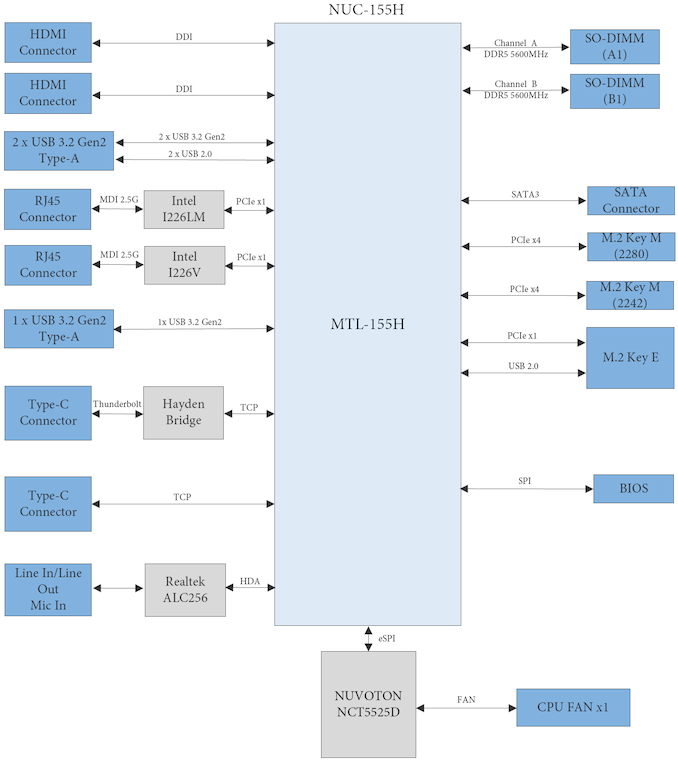
ASRock Industrial NUC BOX-155H Block Diagram
ASRock Industrial uses the Hayden Bridge retimer for the Thunderbolt port, allowing for USB 3.2 Gen 2×2 support on it. In terms of external I/O, the following bus layout diagram provides further insights.

ASRock Industrial NUC BOX-155H Bus Layout
The block diagram below presents the overall high-speed I/O distribution from the NUC 14 Pro technical product manual.
Even though it is not specifically mentioned, the retimers used for both USB4 ports are Hayden Bridge, allowing for USB 3.2 Gen 2×2 support on it. In terms of external I/O, the following bus layout diagram provides further insights.
In today’s review, we compare the ASRock Industrial NUC BOX-155H and the ASUS NUC14RVHv7 with a host of other systems in a similar form-factor. TDPs for the processors range from 15W right up to 65W.
| Comparative PC Configurations | ||
| Aspect | ASUS NUC14RVHv7 (Revel Canyon vPro) | |
| CPU | Intel Core Ultra 7 165H Meteor Lake-H 6P + 8E + 2LPE / 22T, up to 5.0 GHz (P) up to 3.8 GHz (E) up to 2.5 GHz (LPE) Intel 4 (CPU) / TSMC N5 (iGPU), 24MB L2, Min / Max / Base TDP: 20W / 115W / 28W PL1 = 64W, PL2 = 64W |
Intel Core Ultra 7 165H Meteor Lake-H 6P + 8E + 2LPE / 22T, up to 5.0 GHz (P) up to 3.8 GHz (E) up to 2.5 GHz (LPE) Intel 4 (CPU) / TSMC N5 (iGPU), 24MB L2, Min / Max / Base TDP: 20W / 115W / 28W PL1 = 64W, PL2 = 64W |
| GPU | Intel Arc Graphics (8 Xe-cores @ up to 2.3 GHz) |
Intel Arc Graphics (8 Xe-cores @ up to 2.3 GHz) |
| RAM | SK hynix HMCG66AGBSA095N DDR5-5600 SODIMM 46-45-45-90 @ 5600 MHz 2×8 GB |
SK hynix HMCG66AGBSA095N DDR5-5600 SODIMM 46-45-45-90 @ 5600 MHz 2×8 GB |
| Storage | Samsung PM9A1a MZVL2512HDJD (512 GB; M.2 2280 PCIe 4.0 x4 NVMe;) (Samsung 7th Gen. V-NAND 176L (136T) 3D TLC; Samsung Pascal S4LV008 Controller) |
Samsung PM9A1a MZVL2512HDJD (512 GB; M.2 2280 PCIe 4.0 x4 NVMe;) (Samsung 7th Gen. V-NAND 176L (136T) 3D TLC; Samsung Pascal S4LV008 Controller) |
| Wi-Fi | 1x 2.5 GbE RJ-45 (Intel I226-LM) Intel Wi-Fi 6E AX211 (2×2 802.11ax – 2.4 Gbps) |
1x 2.5 GbE RJ-45 (Intel I226-LM) Intel Wi-Fi 6E AX211 (2×2 802.11ax – 2.4 Gbps) |
| Price (in USD, when built) | US $700 (barebones) US $816 (as configured, no OS) |
US $700 (barebones) US $816 (as configured, no OS) |
The next few sections will deal with comparative benchmarks for the above systems.
Our 2022 Q4 update to the test suite for Windows 11-based systems carries over some of the standard benchmarks we have been using over the last several years. While UL’s PCMark makes the list, we have opted to temporarily suspend reporting of BAPCo’s SYSmark scores (pending fixture of the energy consumption aspect). Instead, BAPCO’s CrossMark multi-platform benchmarking tool has been added to the set along with UL’s Procyon suite. While CrossMark employs idle time compression and processes all workloads in an opaque manner, UL’s Procyon processes real-world workloads with user interactions (like BAPCo’s SYSmark). We have augmented the UL Procyon suite benchmark with our own custom energy measurement setup.
UL PCMark 10
UL’s PCMark 10 evaluates computing systems for various usage scenarios (generic / essential tasks such as web browsing and starting up applications, productivity tasks such as editing spreadsheets and documents, gaming, and digital content creation). We benchmarked select PCs with the PCMark 10 Extended profile and recorded the scores for various scenarios. These scores are heavily influenced by the CPU and GPU in the system, though the RAM and storage device also play a part. The power plan was set to Balanced for all the PCs while processing the PCMark 10 benchmark. The scores for each contributing component / use-case environment are also graphed below.
| UL PCMark 10 – Performance Scores | |||

The latest and greatest from Intel usually leads the charts when the new products using them are introduced. Unfortunately, this doesn’t seem to be the case with the Meteor Lake UCFF PCs. In the list above, the GTR7 has the Ryzen 7 7840HS at 65W, and it easily waltzes to the top position. However, even the Ryzen 7 7840U in the 4X4 BOX-7840U at 40W is able to surpass the Meteor Lake UCFF PCs. In fact, other than in digital content creation, none of the three Meteor Lake configurations makes a play for the top position. The reasons for this are manifold – including the available power budgets and clock speeds, which we will analyze in a later section.
UL Procyon v2.1.544
PCMark 10 utilizes open-source software such as Libre Office and GIMP to evaluate system performance. However, many of their professional benchmark customers have been requesting evaluation with commonly-used commercial software such as Microsoft Office and Adobe applications. In order to serve their needs, UL introduced the Procyon benchmark in late 2020. There are five benchmark categories currently – Office Productivity, AI Inference, Battery Life, Photo Editing, and Video Editing. AI Inference benchmarks are available only for Android devices, while the battery life benchmark is applicable to Windows devices such as notebooks and tablets. We presents results from our processing of the other three benchmarks.
| UL Procyon – Office Productivity Scores | |||
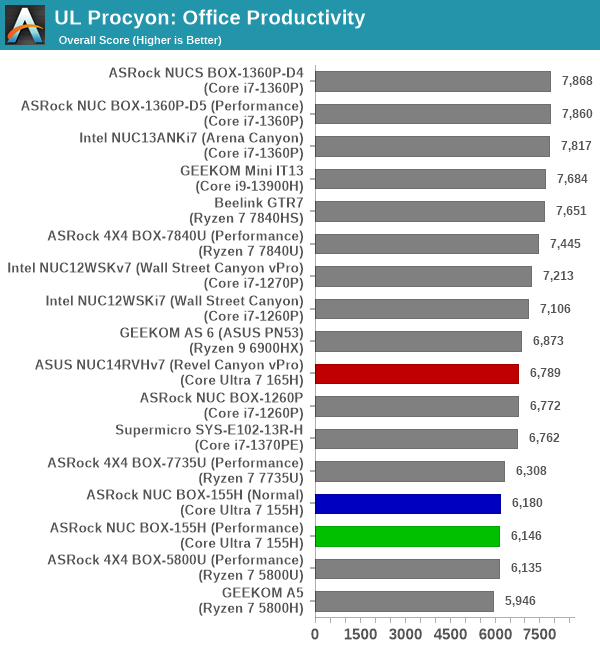
The Meteor Lake configurations perform poorly across all the office workloads, losing out to even the Wall Street Canyon NUC. It is highly likely that the Windows Thread Director is not working as intended, and tasks are ending up in the efficiency or low-power efficiency cores.

Things aren’t much better from an energy consumption viewpoint either. While the absolute scores put the MTL systems in the bottom half of the comparison pack, the energy numbers see it moving slightly up. Overall, there seems to be an uptick in the power efficiency, but that isn’t much to write home about when the Arena Canyon NUC ends up performing better across the board in both performance and energy efficiency metrics.
Moving on to the evaluation of Adobe Photoshop and Adobe Lightroom, we find that the NUC BOX-155H in its 40W avatar has slightly more graphics prowess compared to the NUC14RVHv7. However, the scores are still in the bottom half of the pack.
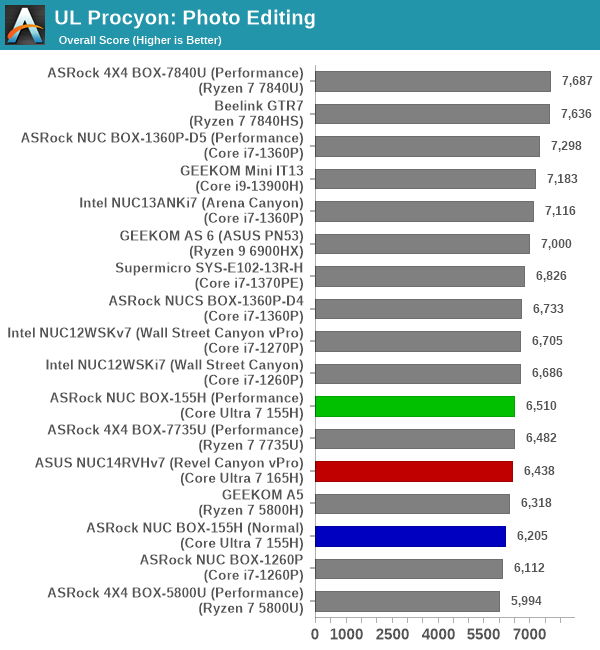
While the ASRock Industrial NUC BOX-155H in a 28W configuration gets the job done with relatively low energy consumption (still behind the latest AMD-based systems), the NUC14RVHv7 with its 64W PL1 slips to the bottom half of the pack without the performance numbers to show for it.
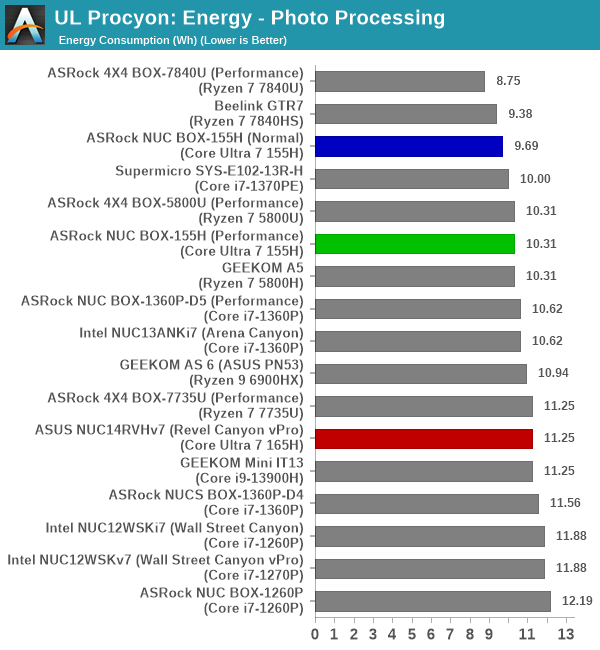
UL Procyon evaluates performance for video editing using Adobe Premier Pro.
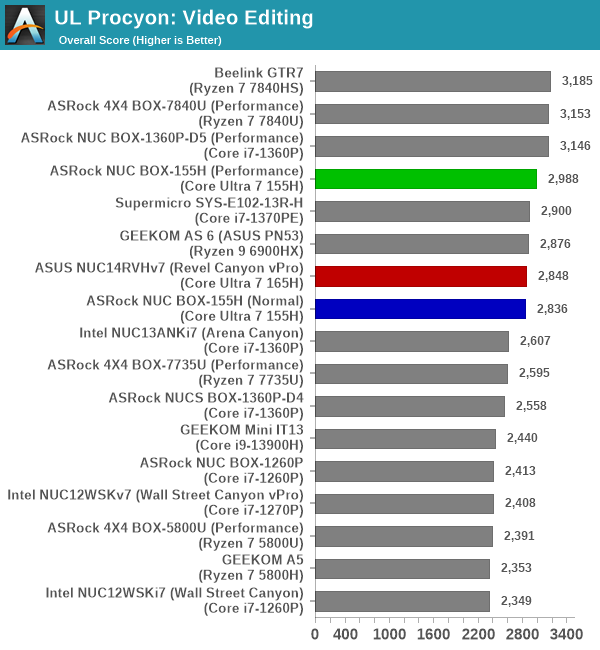
The GPU capabilities again make a difference here, and we see the 40W NUC BOX-155H perform well enough to be in the top half of the pack. It is still behind the latest AMD systems, just like what was seen in the performance for photo processing.
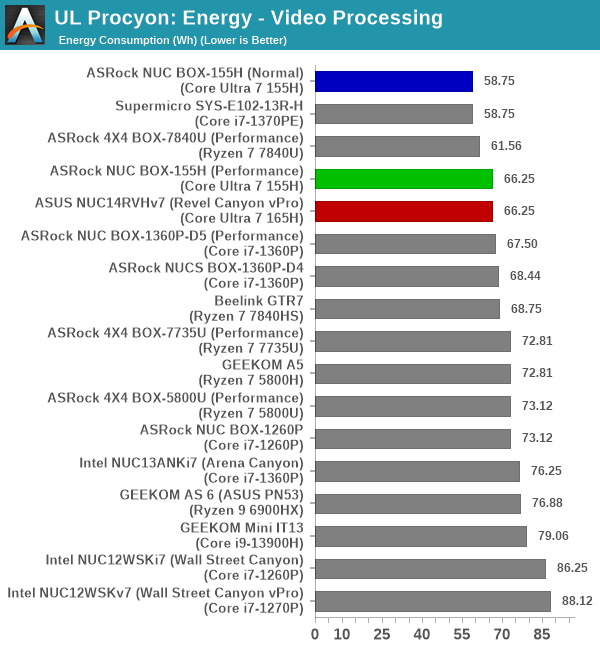
Meteor Lake finally scores a win in the energy consumption metric for this workload with the 28W configuration of the NUC BOX-155H. The chiplet architecture seems to benefit here, with even the 40W and 64W PL1 configurations making it to the top half of the pack.
BAPCo CrossMark 1.0.1.86
BAPCo’s CrossMark aims to simplify benchmark processing while still delivering scores that roughly tally with SYSmark. The main advantage is the cross-platform nature of the tool – allowing it to be run on smartphones and tablets as well.
| BAPCo CrossMark 1.0.1.86 – Sub-Category Scores | |||
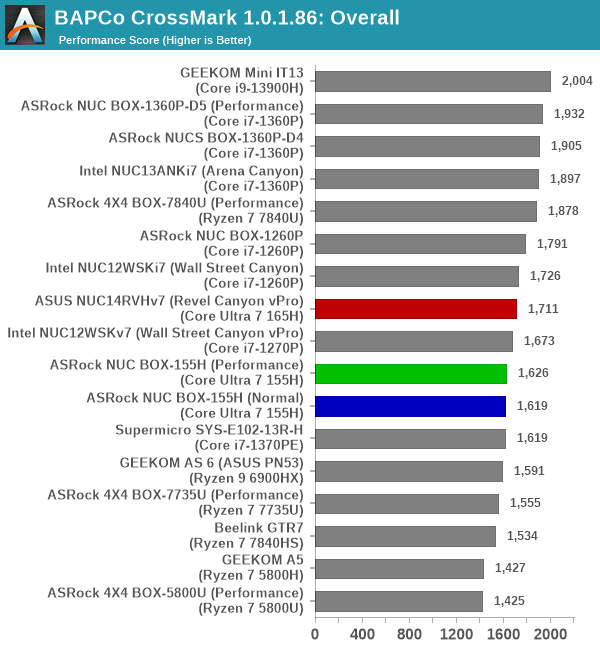
The relative performance seen in the PC Mark 10 workloads translate to CrossMark also, as expected. Things are quite dire for Meteor Lake here – even the Wall Street Canyon NUC based on Alder Lake seems to perform better than all three tested MTL-H configurations.
Standardized benchmarks such as UL’s PCMark 10 and BAPCo’s CrossMark take a holistic view of the system and process a wide range of workloads to arrive at a single score. Some systems are required to excel at specific tasks – so it is often helpful to see how a computer performs in specific scenarios such as rendering, transcoding, JavaScript execution (web browsing), etc. This section presents focused benchmark numbers for specific application scenarios.
3D Rendering – CINEBENCH R23
We use CINEBENCH R23 for 3D rendering evaluation. R23 provides two benchmark modes – single threaded and multi-threaded. Evaluation of different PC configurations in both supported modes provided us the following results.
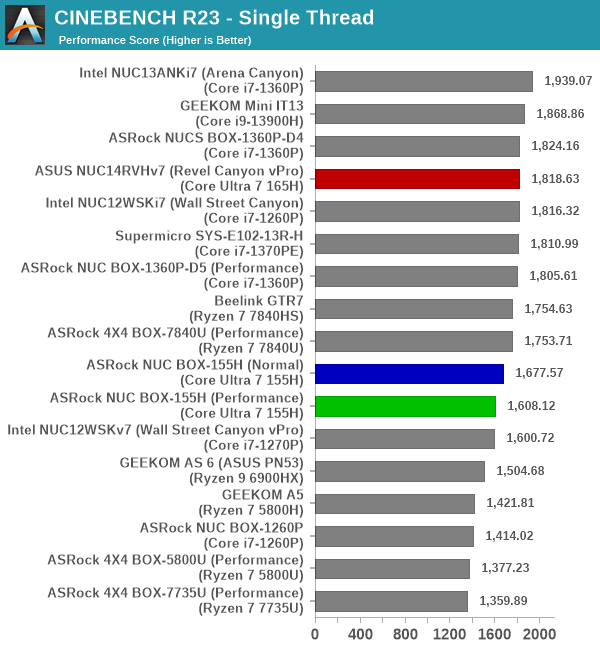
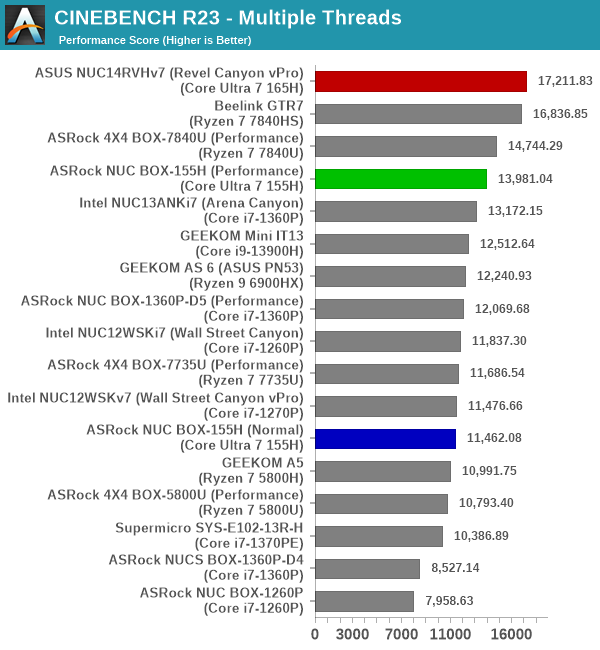
The thermal solution in the NUC14RVHv7 is able to sustain a 64W PL1 for quite a long duration – enough to help it get past the NUC BOX-155H configurations for single-threaded rendering performance. Unfortunately, the Raptor Lake-based systems happen to perform better than even the NUC14RVHv7 for single-threaded scores. In the multi-threaded case, the increased thread count (22 in the NUC14RVHv7 with a power budget of 64W) helps the Reven Canyon NUC emerge at the top spot, narrowly getting past the Beelink GTR7 (with its 16 high-performance threads and a power budget of 65W).
Transcoding: Handbrake 1.5.1
Handbrake is one of the most user-friendly open source transcoding front-ends in the market. It allows users to opt for either software-based higher quality processing or hardware-based fast processing in their transcoding jobs. Our new test suite uses the ‘Tears of Steel’ 4K AVC video as input and transcodes it with a quality setting of 19 to create a 720p AVC stream and a 1080p HEVC stream.
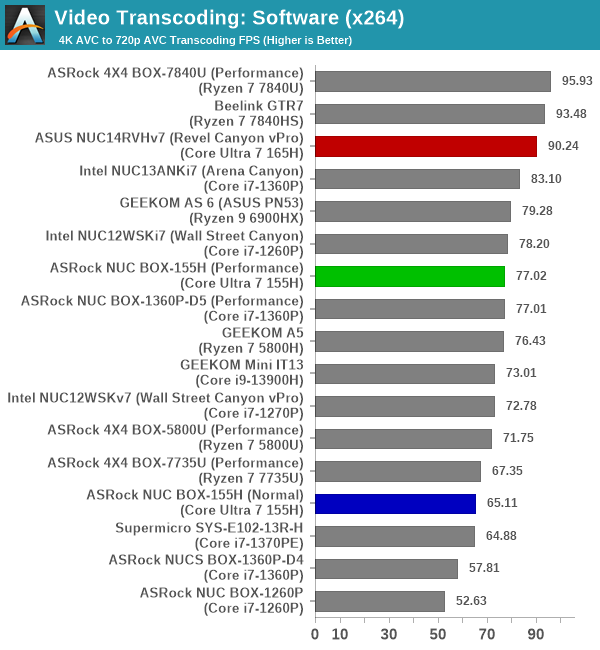

The more the number of available threads, and higher the available power budget, the better is the software transcoding performance. As a result, we see the 8 high-performance cores in the latest AMD systems helping to get past the 6 in the Meteor Lake ones. However, the NUC14RVHv7 is able to wrest back a narrow lead in the x265 encoding performance, thanks to its 64W power budget.

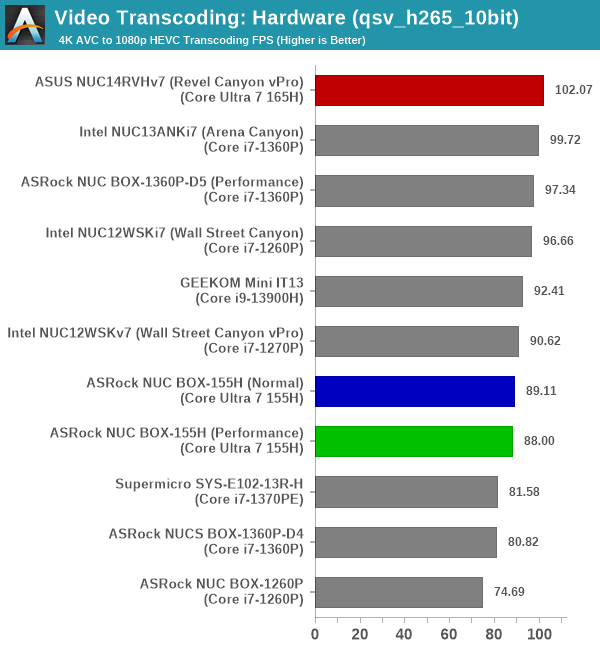
The QuickSync transcoding engine in the Revel Canyon NUC performs the best for hardware-accelerated transcoding. It is likely due to the faster clock for the engine, coupled with its 64W power budget.
Archiving: 7-Zip 21.7
The 7-Zip benchmark is carried over from our previous test suite with an update to a newer version of the open source compression / decompression software.
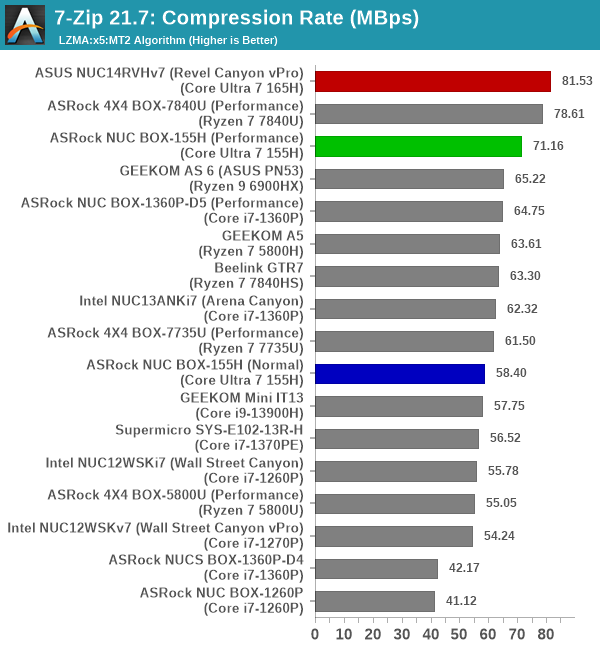
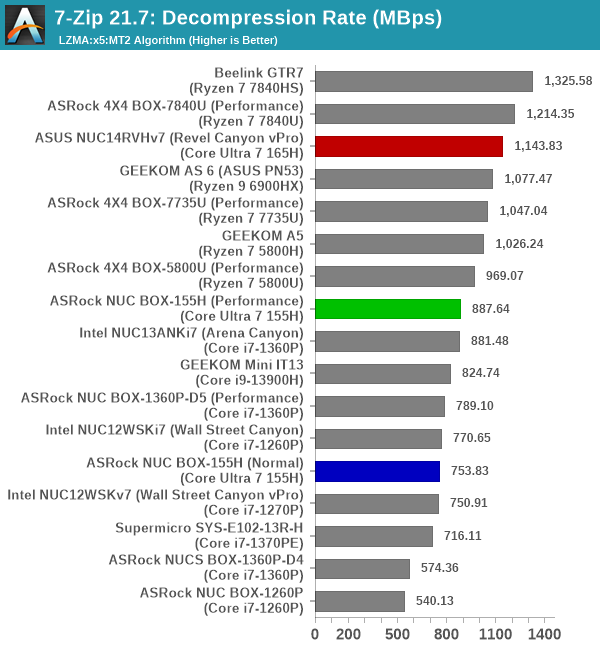
There is a marked improvement in the compression rate, allowing the Meteor Lake systems to perform as well as the latest AMD-based ones. However, the 64W power budget of the NUC15RVHv7 is essential for the top spot. Decompression is a different story, though. The AMD systems perform much better despite the lower available power budget.
Web Browsing: JetStream, Speedometer, and Principled Technologies WebXPRT4
Web browser-based workloads have emerged as a major component of the typical home and business PC usage scenarios. For headless systems, many applications based on JavaScript are becoming relevant too. In order to evaluate systems for their JavaScript execution efficiency, we are carrying over the browser-focused benchmarks from the WebKit developers used in our notebook reviews. Hosted at BrowserBench, JetStream 2.0 benchmarks JavaScript and WebAssembly performance, while Speedometer measures web application responsiveness.
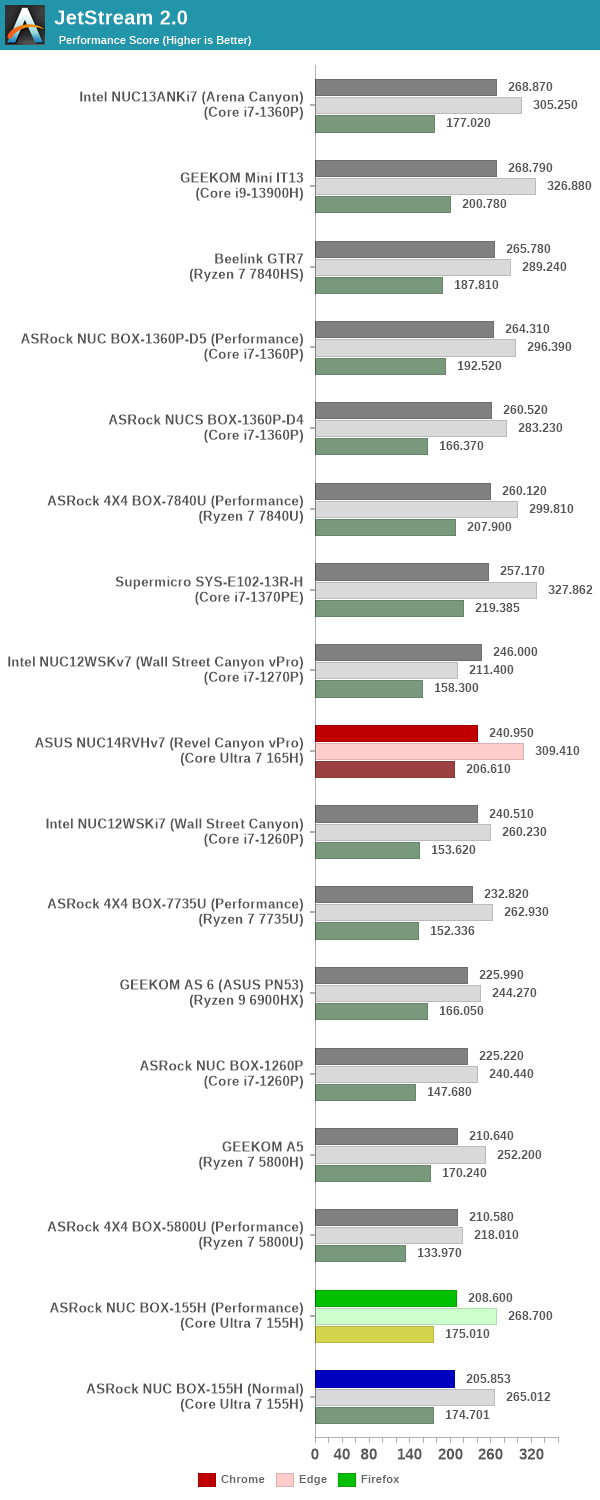
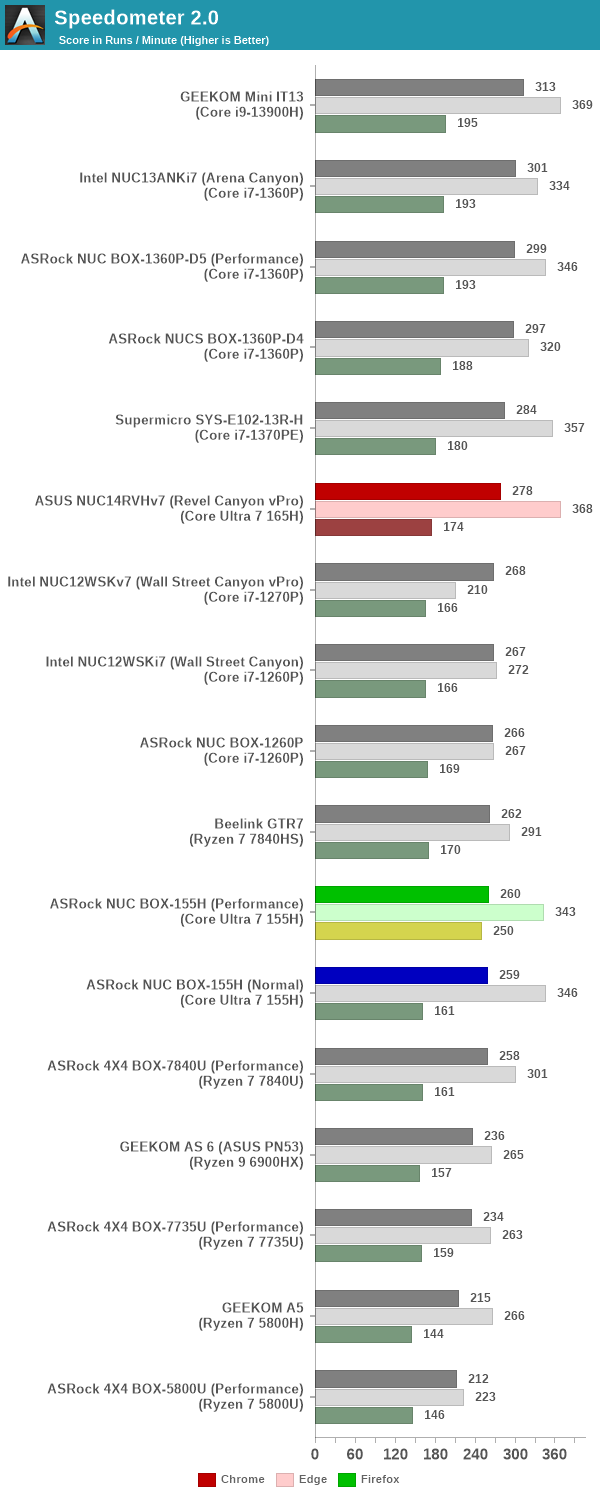
From a real-life workload perspective, we also process WebXPRT4 from Principled Technologies. WebXPRT4 benchmarks the performance of some popular JavaScript libraries that are widely used in websites.

Web browser benchmarks have typically been an easy win for Intel-based systems because of their excellent single-threaded performance. However, Meteor Lake makes a not-so-impressive entry into the list with a middle-of-the-road performance across the board.
Application Startup: GIMP 2.10.30
A new addition to our systems test suite is AppTimer – a benchmark that loads up a program and determines how long it takes for it to accept user inputs. We use GIMP 2.10.30 with a 50MB multi-layered xcf file as input. What we test here is the first run as well as the cached run – normally on the first time a user loads the GIMP package from a fresh install, the system has to configure a few dozen files that remain optimized on subsequent opening. For our test we delete those configured optimized files in order to force a `fresh load’ every second time the software is run.
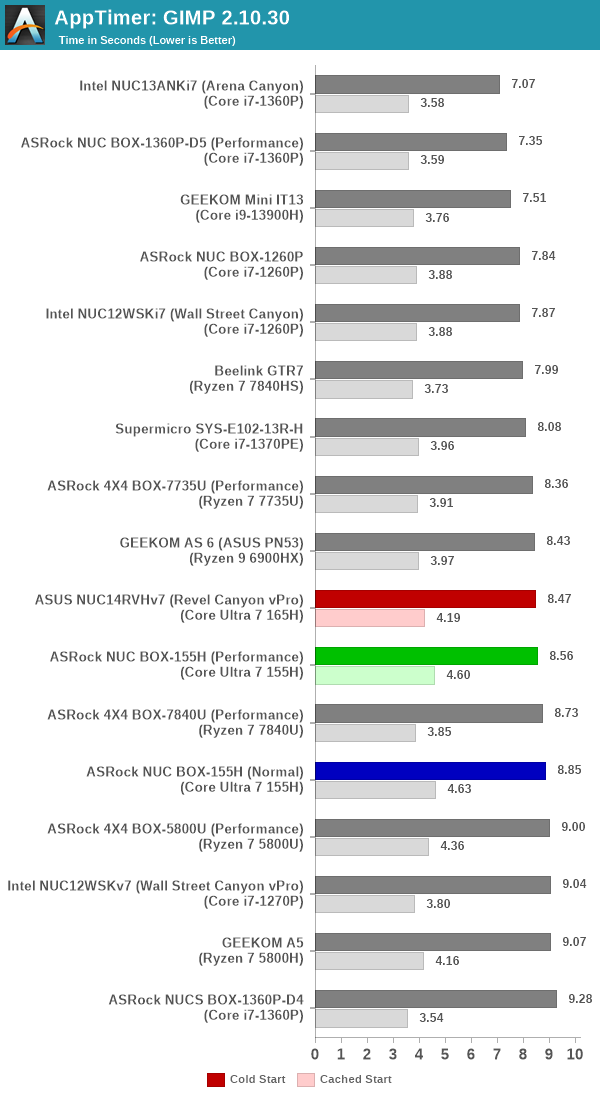
As it turns out, GIMP does optimizations for every CPU thread in the system, which requires that higher thread-count processors take a lot longer to run. So the test runs quick on systems with fewer threads, however fast cores are also needed. This combination is a bit of a penalty for hybrid processors. Allocation of the tasks to efficiency cores may result in a significant drop in user experience / response time. Overall, the Meteor Lake performance improvements stand out in some specific scenarios, but is still not convincing enough.
Cryptography Benchmarks
Cryptography has become an indispensable part of our interaction with computing systems. Almost all modern systems have some sort of hardware-acceleration for making cryptographic operations faster and more power efficient. In the case of IoT servers, many applications – including web server functionality and VPN – need cryptography acceleration.
BitLocker is a Windows features that encrypts entire disk volumes. While drives that offer encryption capabilities are dealt with using that feature, most legacy systems and external drives have to use the host system implementation. Windows has no direct benchmark for BitLocker. However, we cooked up a BitLocker operation sequence to determine the adeptness of the system at handling BitLocker operations. We start off with a 4.5GB RAM drive in which a 4GB VHD (virtual hard disk) is created. This VHD is then mounted, and BitLocker is enabled on the volume. Once the BitLocker encryption process gets done, BitLocker is disabled. This triggers a decryption process. The times taken to complete the encryption and decryption are recorded. This process is repeated 25 times, and the average of the last 20 iterations is graphed below.
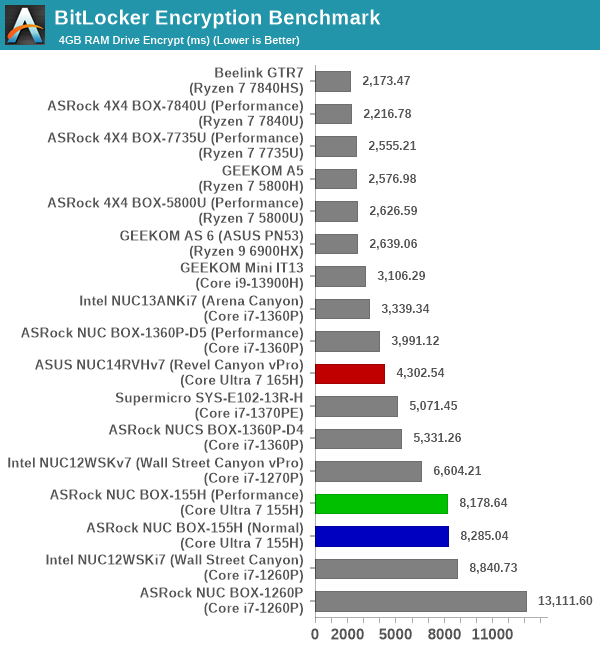
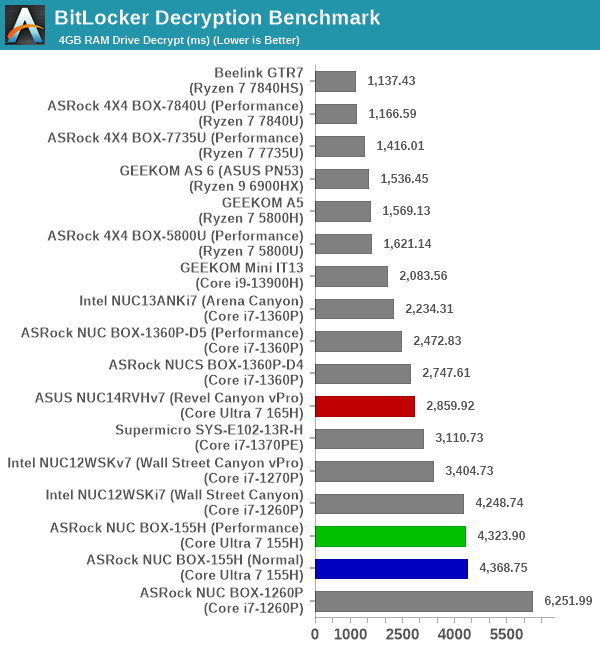
Hardware acceleration is available for the operations in all of the systems. The time taken for processing is directly dependent on the available power budget and the clock speeds for the hardware engine. Slotting in behind Raptor Lake-P systems despite a higher available power budget is a worrying trend.
The integrated GPU in Meteor Lake-H is a pared down version of the one used in Intel’s discrete Arc GPUs. The Meteor Lake-H architecture isolates the media engine and display pipe away from the GPU tile. The new iGPU also includes ray-tracing support.
GPU performance evaluation typically involved gaming workloads, and for select PCs, GPU compute. Prior to that, a look at the capabilities of the GPUs in the two MTL-H systems being evaluated today.
The Intel Arc Graphics in the two systems is a completely new architecture for the mobile processor market. The two different systems have largely similar iGPU configurations, with the notable difference being that the one in the Revel Canyon NUC can operate at up to 50 MHz more. The performance of the Arc iGPU helps Intel regain parity with the new RDNA3-based iGPU in the latest AMD-based systems, as shown in the benchmarks below.
GFXBench
The DirectX 12-based GFXBench tests from Kishonti are cross-platform, and available all the way down to smartphones. As such, they are not very taxing for discrete GPUs and modern integrated GPUs. We processed the offscreen versions of the ‘Aztec Ruins’ benchmark.
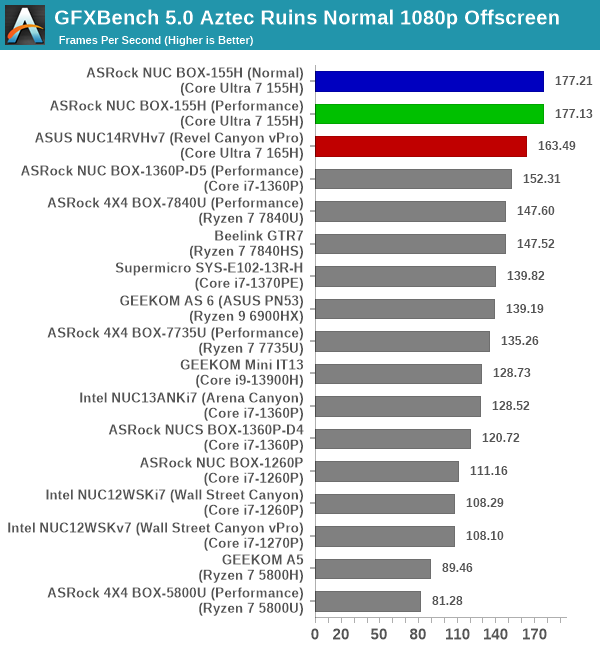
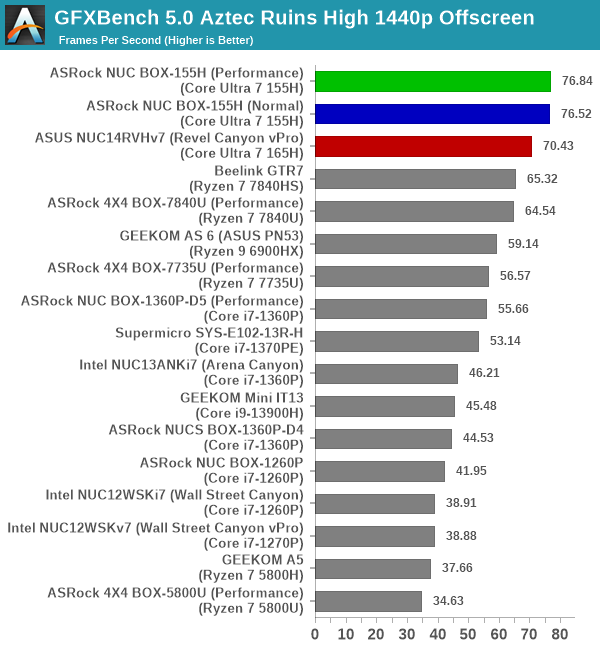
Interestingly, we see the configuration with the slightly lower GPU speeds in the NUC BOX-155H come out with better numbers compared to the Revel Canyon NUC with a faster clock. It is a trend we will observe right through this section, and is probably related to the power budget allocated to the iGPU.
UL 3DMark
Four different workload sets were processed in 3DMark – Fire Strike, Time Spy, Night Raid, and Wild Life.
3DMark Fire Strike
The Fire Strike benchmark has three workloads. The base version is meant for high-performance gaming PCs. It uses DirectX 11 (feature level 11) to render frames at 1920 x 1080. The Extreme version targets 1440p gaming requirements, while the Ultra version targets 4K gaming system, and renders at 3840 x 2160. The graph below presents the overall score for the Fire Strike Extreme and Fire Strike Ultra benchmark across all the systems that are being compared.
| UL 3DMark – Fire Strike Workloads | |||
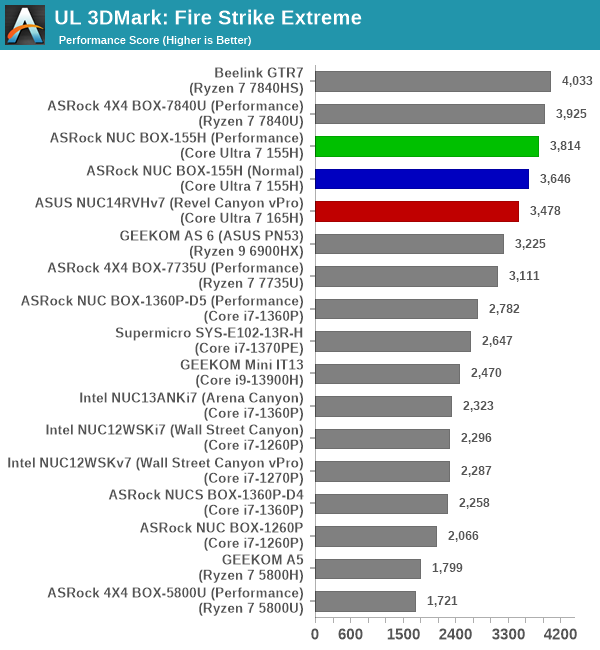
The RDNA3 iGPU in the Phoenix-based systems manages to come out on top in the two workloads, but the Meteor Lake-based systems are right behind, with the internal ordering the same as what was observed in the previous test. There is a significant uplift over the NUCs in the previous generations.
3DMark Time Spy
The Time Spy workload has two levels with different complexities. Both use DirectX 12 (feature level 11). However, the plain version targets high-performance gaming PCs with a 2560 x 1440 render resolution, while the Extreme version renders at 3840 x 2160 resolution. The graphs below present both numbers for all the systems that are being compared in this review.
| UL 3DMark – Time Spy Workloads | |||
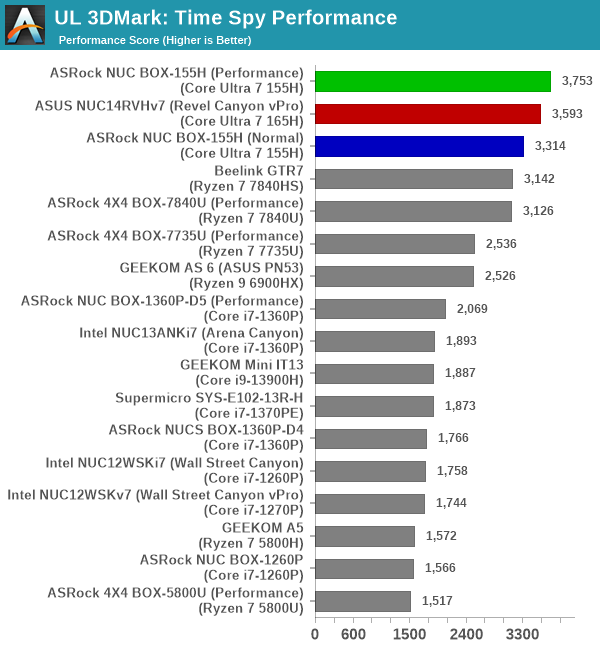
The Arc iGPU in Meteor Lake takes up the top three spots in both Time Spy configurations, as shown above. The two Phoenix-based systems take up the next two spots.
3DMark Wild Life
The Wild Life workload was initially introduced as a cross-platform GPU benchmark in 2020. It renders at a 2560 x 1440 resolution using Vulkan 1.1 APIs on Windows. It is a relatively short-running test, reflective of mobile GPU usage. In mid-2021, UL released the Wild Life Extreme workload that was a more demanding version that renders at 3840 x 2160 and runs for a much longer duration reflective of typical desktop gaming usage.
| UL 3DMark – Wild Life Workloads | |||
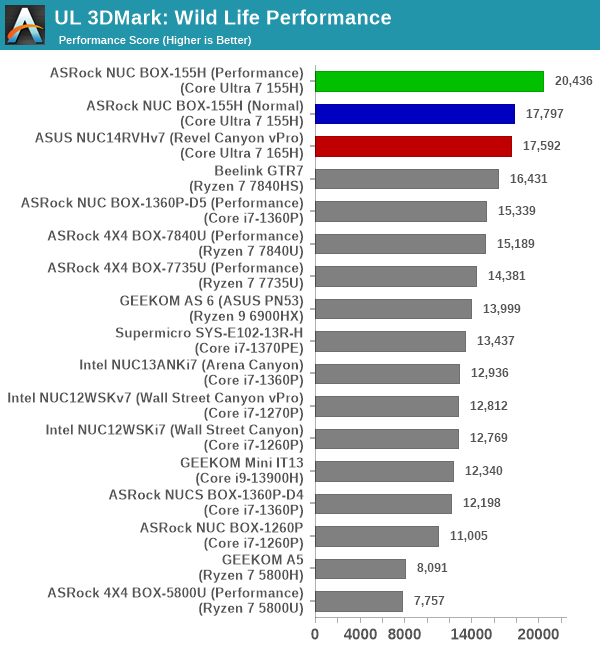
The 1440p version sees the Meteor Lake-based systems on top, but the 4K version sees a much closer fight. The two Phoenix-based systems take up the first and third spots, while the 40W NUC BOX-155H manages to sneak in between them.
3DMark Night Raid
The Night Raid workload is a DirectX 12 benchmark test. It is less demanding than Time Spy, and is optimized for integrated graphics. The graph below presents the overall score in this workload for different system configurations.

RDNA3 scores a win here, with the Phoenix-based systems taking up the top two spots and followed immediately by the three MTL-H configurations.
3DMark Port Royal
UL introduced the Port Royal ray-tracing benchmark as a DLC for 3DMark in early 2019. The scores serve as an indicator of how the system handles ray-tracing effects in real-time.
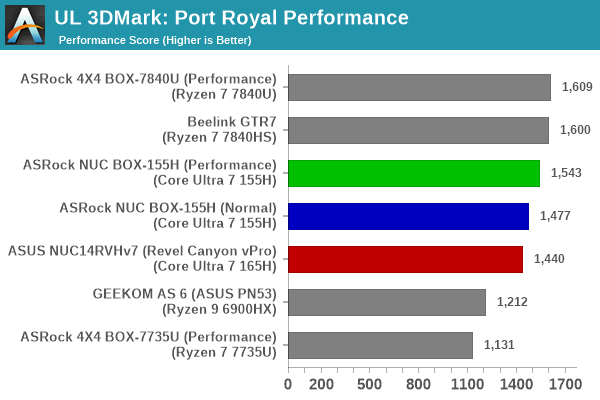
RDNA3’s ray tracing performance is slightly better than that of MTL-H. The RDNA2 ray tracing in the Rembrandt SoC makes up the bottom half of the pack.
Drafting a set of benchmarks relevant to end-user AI use-cases has proved to be a challenging exercise. While training workloads are common in the datacenter and enterprise space, consumer workloads are focused on inference. In early days, the inferencing used to run in the cloud, but increasing privacy concerns, as well as the penalties associated with constant cloud communication, have contributed to the rise in demand for local inferencing capabilities. Additionally, generative AI (such as chatbots and image generators based on input prompts) has also garnered significant interest in recent days. Currently, most of these large-language models (LLMs) run in the cloud, as they are still too resource-heavy to run with reasonable performance in the systems of average users.
UL’s Procyon AI benchmarks focuses on these workloads from an edge computing perspective. Broadly speaking, the benchmark is divided into two major components:
- Computer Vision (inference performance using six different neural network models)
- Generative AI (image generation using the Stable Diffusion LLM)
An attempt was made to process both benchmarks on the ASUS NUC14RVHv7 (Revel Canyon vPro) as well as the two configurations of the ASRock Industrial NUC BOX-155H as part of the evaluation of its capabilities as an “AI PC”. The results are summarized in the remainder of this section.
Computer Vision Neural Networks Performance
The six supported neural networks were benchmarked with the following configurations:
- OpenVINO CPU with float32 precision
- OpenVINO GPU with float16 precision
- OpenVINO GPU with float32 precision
- OpenVINO GPU With integer precision
- OpenVINO NPU with float16 precision
- OpenVINO NPU with integer precision
- WinML GPU with float16 precision
- WinML GPU with float32 precision
- WinML GPU with integer precision
The OpenVINO configurations can be evaluated only on systems with an Intel CPU or GPU or NPU. In general, a neural network model’s accuracy / quality of results improves with precision. In other words, we expect float16 to deliver better results than integer, and float32 to be better than float16. However, increased precision requires more complex calculations and that results in higher power consumption. As general purpose engines, the CPU is expected to be the most power hungry of the lot, while the NPUs which are purpose-built for neural network acceleration are expected to be better than the GPU configurations. UL has a detailed study of the variation in the quality of results with precision for different networks in their benchmark resources section.
The YOLO V3 network is used for real-time object detection in videos. The graphs below show that at the same precision, OpenVINO performs better than WinML on the GPU. Additionally, for the same precision, OpenVINO performs better on the GPU rather than the NPU.
| UL Procyon AI – YOLO V3 Average Inference Time | |||
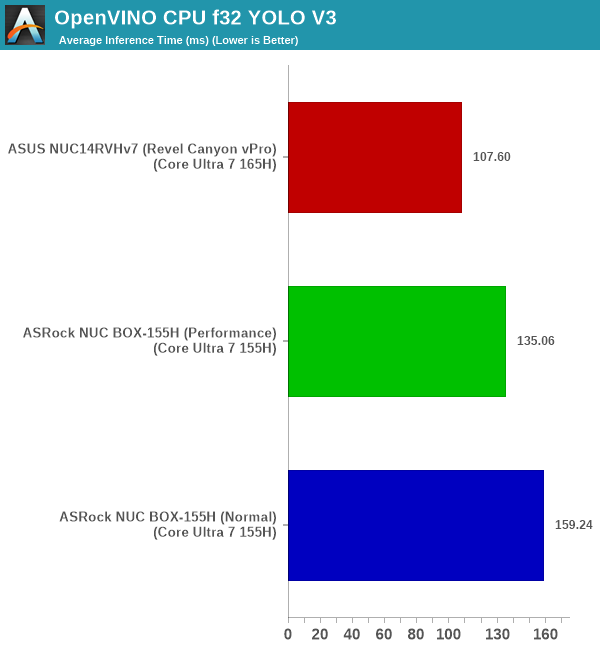
The REAL ESRGAN network is used for upscaling images / restoration of videos and pictures. Relative performance for different precisions / execution hardware is similar to what was seen for the YOLO V3 network.
| UL Procyon AI – REAL ESRGAN Average Inference Time | |||
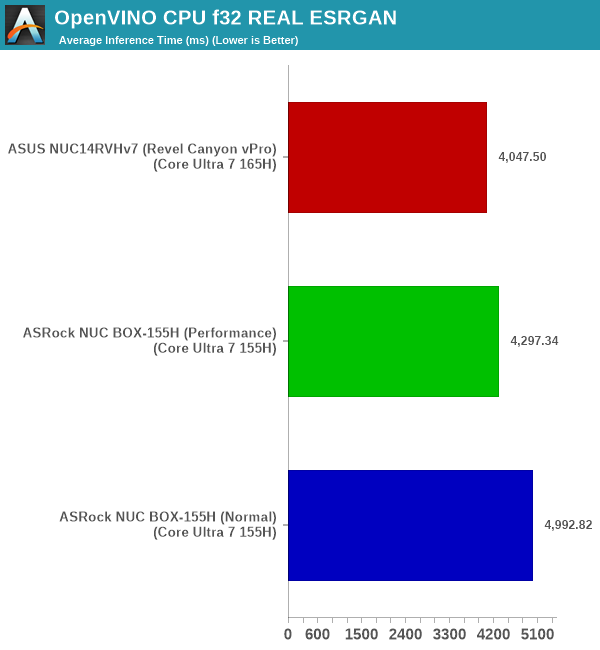
The ResNet 50 network is primarily used for image classification. Again, we see the NPU being slower than the GPU at the same precision, while WinML lags behind OpenVINO for the same underlying execution hardware and precision.
| UL Procyon AI – ResNet 50 Average Inference Time | |||
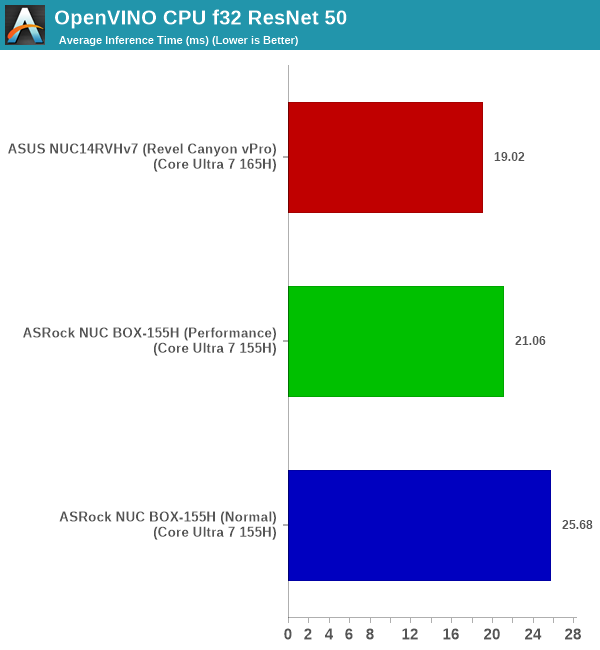
The MobileNet V3 network is used, among other things, for image processing tasks such as tilt correction. Similar to the other networks, WinML again lags behind OpenVINO. However, the NPU is faster than the GPU for the same precision network.
| UL Procyon AI – MobileNet V3 Average Inference Time | |||
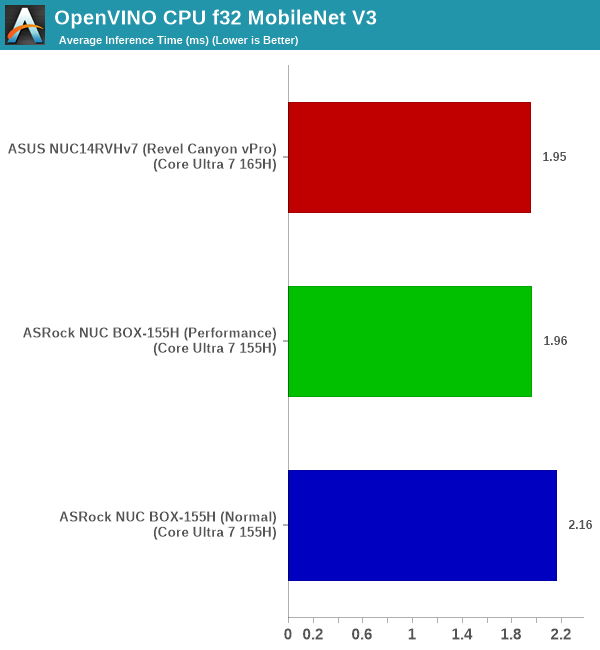
The Inception V4 network, like the ResNet 50, is primarily used for image classification. Similar to most other networks, WinML performance is not as good as with OpenVINO, and the NPU is slower than the GPU for the same precision.
| UL Procyon AI – Inception V4 Average Inference Time | |||
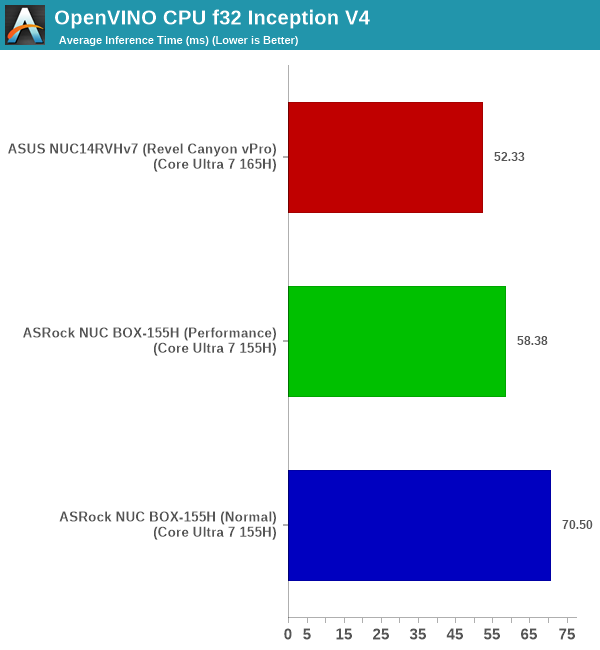
The DeepLab V3 network is used for image segmentation. In other words, it identifies groups of pixels in an image that satisfies specific requirements. The NPU is almost 4x slower than the GPU for the same precision and network. OpenVINO continues to perform better than WinML for the same precision network/
| UL Procyon AI – DeepLab V3 Average Inference Time | |||
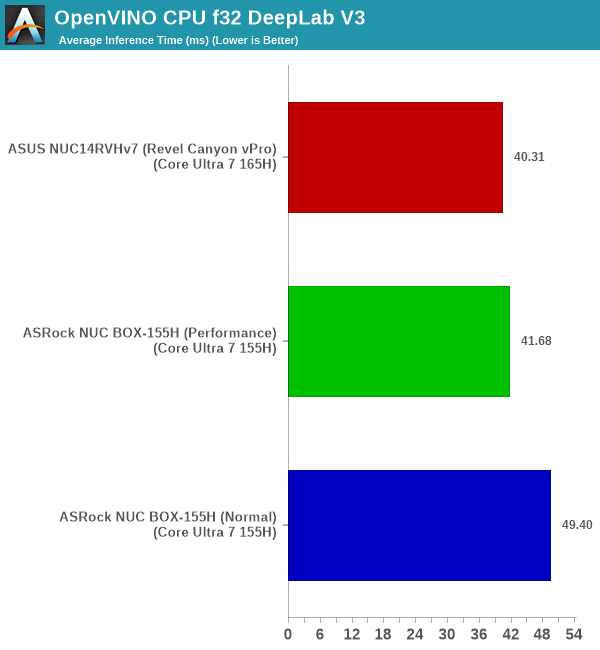
The UL Procyon AI Computer Vision benchmark run processes each model for 3 minutes, maintaining a count of inferences as well as the average time taken for each inference. It presents an overall score for all six models together, though it is possible that some networks perform better than others for the same hardware / precision configuration.
| UL Procyon AI – Computer Vision Inferencing Overall Scores | |||
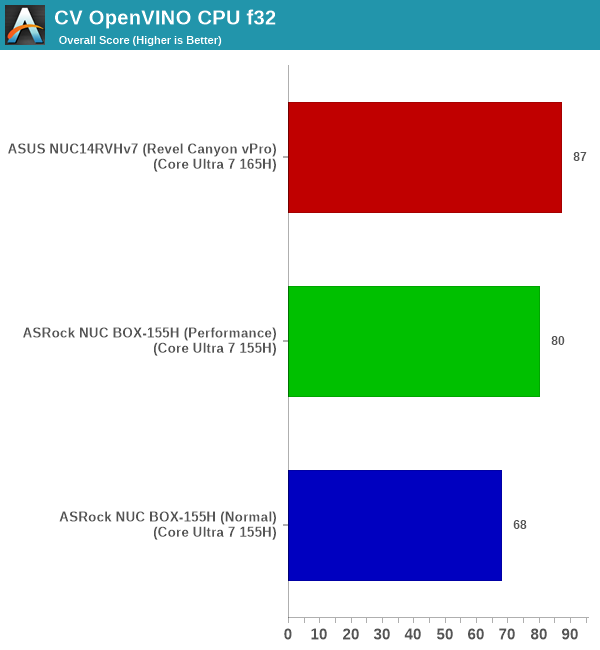
The Revel Canyon NUC comes out on top in the CPU-only OpenVINO run with float32 precision. For the OpenVINO GPU runs, the NUC BOX-155H manages to sneak in a slight lead over the other systems. Finally, WinML performance is quite bad compared to OpenVINO.
The benchmark runs for a fixed time. Hence, instead of tracking energy consumption, we opt to report the average at-wall power consumption for the system as a whole for each run set.
| UL Procyon AI – Computer Vision Average Power Consumption | |||
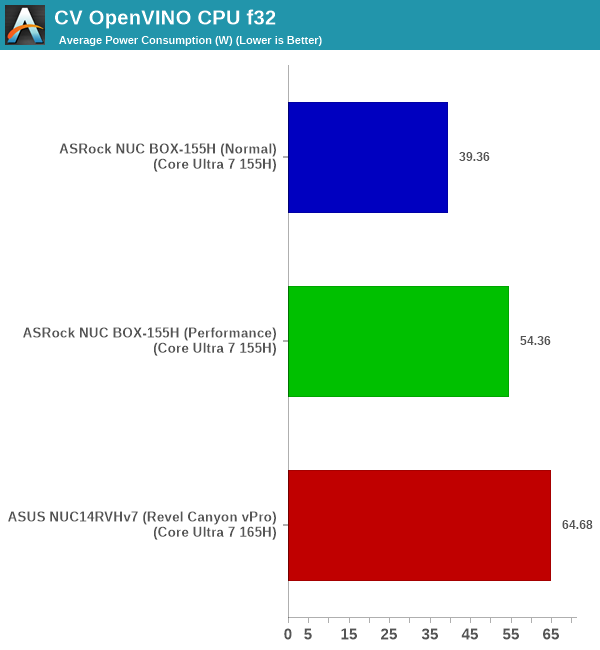
As expected, the NPU is the most power-efficient of the lot. Higher precision translates to higher power consumption, and CPU mode is the least power-efficient.
Generative AI Performance
The Stability Diffusion prompt used for benchmarking in UL Procyon AI generates 16 different images. However, on all three system configurations, the benchmark crashed after generating 3 or 4 images. This benchmark is meant for high-end systems with discrete GPUs, and hence we didn’t bother to follow up on the crashes.
As we get more systems processed with the UL Procyon AI benchmark, an attempt will be made to get the Generative AI benchmark working on them.
The 2022 Q4 update to our system reviews brings an updated HTPC evaluation suite for systems. After doing away with the evaluation of display refresh rate stability and Netflix streaming evaluation, the local media playback configurations have also seen a revamp. This section details each of the workloads processed on the ASUS NUC14RVHv7 (Revel Canyon vPro) and the ASRock Industrial NUC BOX-155H as part of the HTPC suite. Prior to that, a discussion of the changes in MTL-H relevant to multimedia processing is in order.
Meteor Lake moves the media engine (decoder / encoder) as well as the display engine away from the GPU tile to the SoC tile. The media engine supports a variety of codecs and also supports limited video post-processing.
YouTube Streaming Efficiency
YouTube continues to remain one of the top OTT platforms, primarily due to its free ad-supported tier. Our HTPC test suite update retains YouTube streaming efficiency evaluation as a metric of OTT support in different systems. Mystery Box’s Peru 8K HDR 60FPS video is the chosen test sample. On PCs running Windows, it is recommended that HDR streaming videos be viewed using the Microsoft Edge browser after putting the desktop in HDR mode.
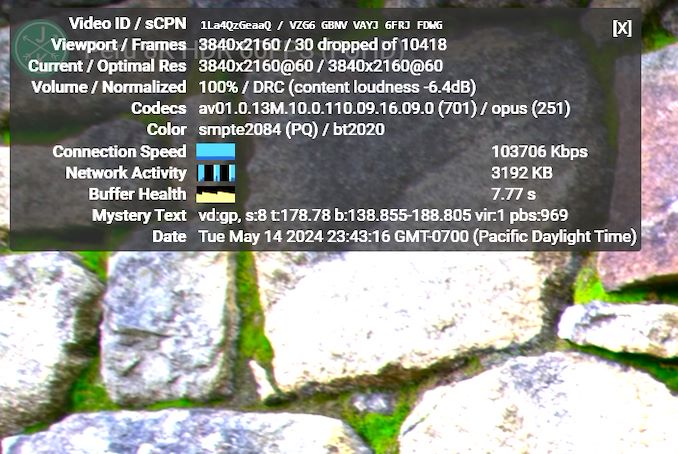
YouTube Streaming Statistics – ASRock Industrial NUC BOX-155H
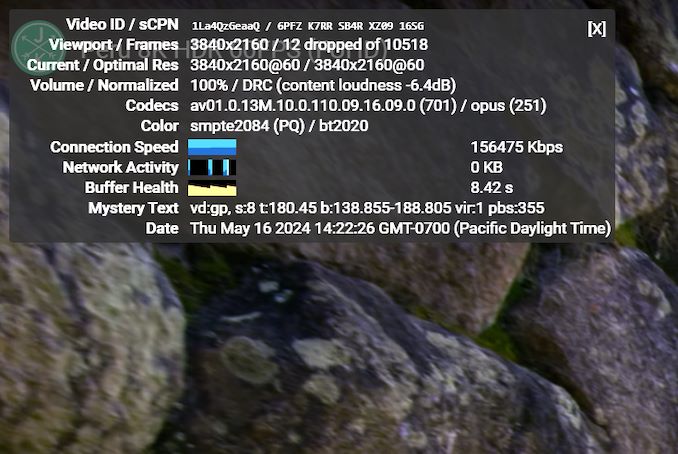
YouTube Streaming Statistics – ASUS NUC14RVHv7
Meteor Lake supports hardware decoding of AV1, and we see the stream encoded with that codec being played back. The streaming is perfect, thanks to the powerful GPU and hardware decoding support – the few dropped frames observed in the statistics below are due to mouse clicks involved in bringing up the overlay.
The streaming efficiency-related aspects such as GPU usage and at-wall power consumption are also graphed below.
| YouTube Network Streaming Efficiency | |||
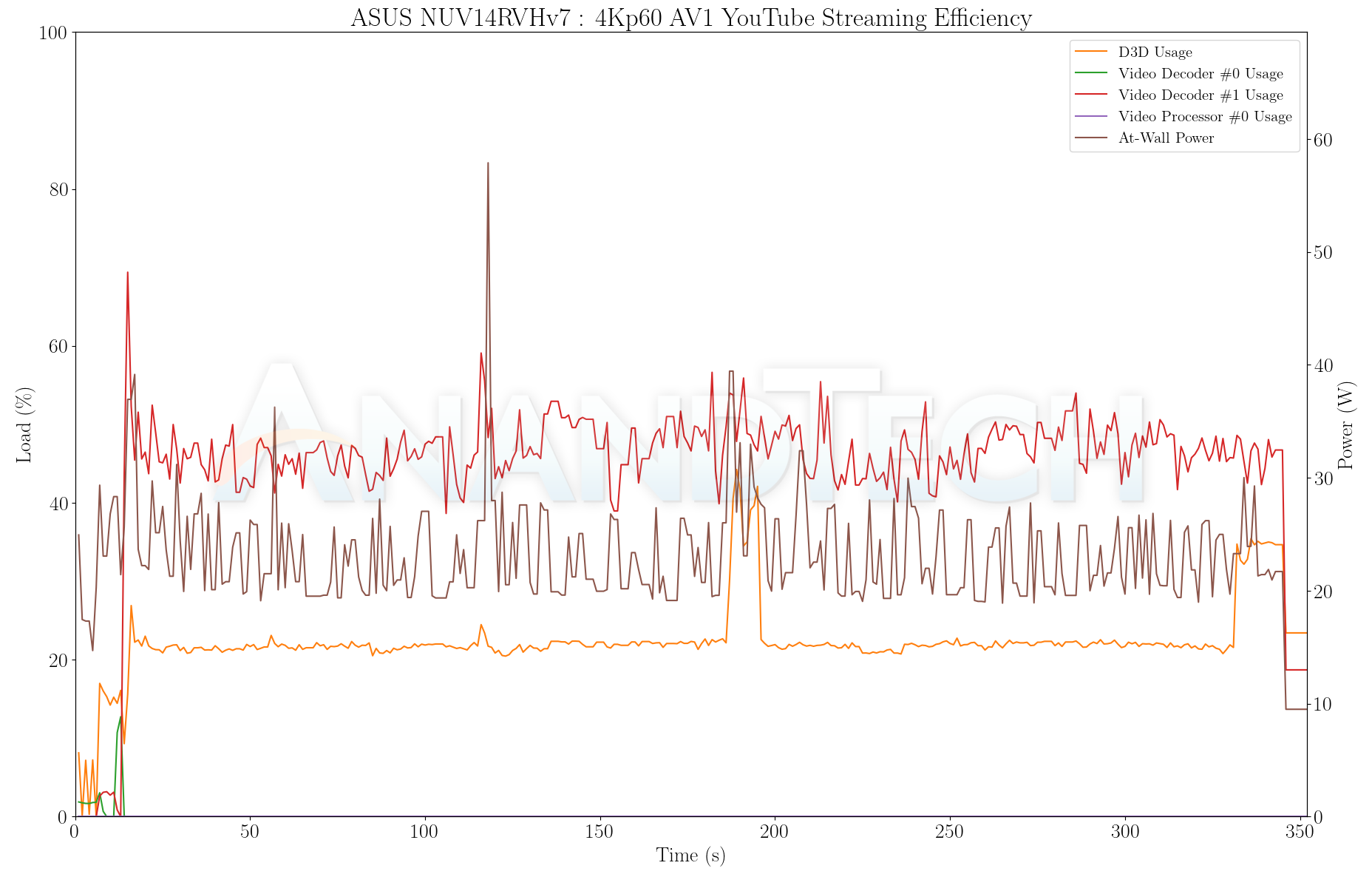
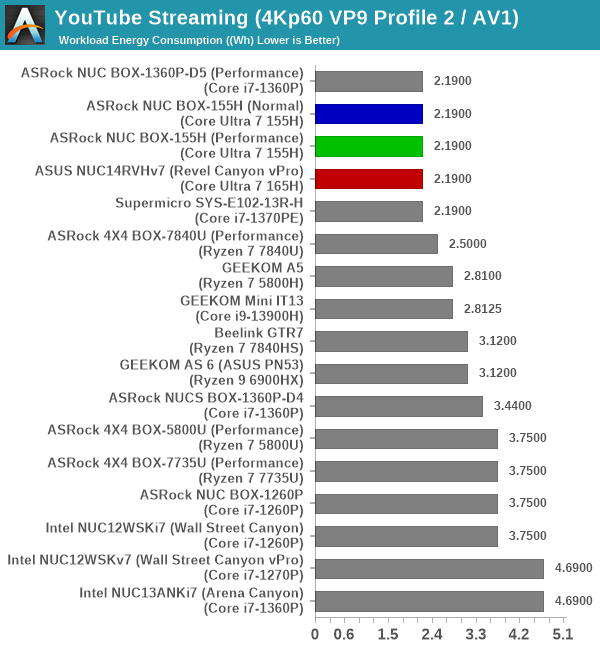
Since almost all of the processing for streaming occurs in the SoC tile, all three system configurations are quite frugal in the energy consumption aspect for the job.
Hardware-Accelerated Encoding and Decoding
The transcoding benchmarks in the systems performance section presented results from evaluating the QuickSync encoder within Handbrake’s framework. We usually check the capabilities of the decoder engine using DXVAChecker, but the software (4.6.0) unfortunately crashes while attempting to execute processes in some DLLs in the Arc GPU drivers. Fortunately, Intel has a comprehensive table of supported codecs and pixel formats in the media engine.
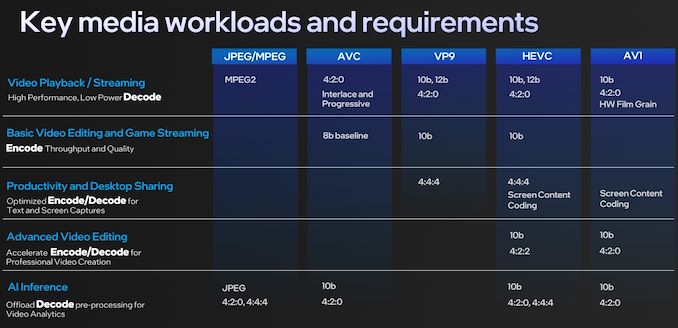
Video Decoding Hardware Acceleration in the ASUS NUC14RVHv7 (Revel Canyon vPro) and ASRock Industrial NUC BOX-155H
The supported codecs list is good enough even for professional applications.
Local Media Playback
Evaluation of local media playback and video processing is done by playing back files encompassing a range of relevant codecs, containers, resolutions, and frame rates. A note of the efficiency is also made by tracking GPU usage and power consumption of the system at the wall. Users have their own preference for the playback software / decoder / renderer, and our aim is to have numbers representative of commonly encountered scenarios. Our Q4 2022 test suite update replaces MPC-HC (in LAV filters / madVR modes) with mpv. In addition to being cross-platform and open-source, the player allows easy control via the command-line to enable different shader-based post-processing algorithms. From a benchmarking perspective, the more attractive aspect is the real-time reporting of dropped frames in an easily parseable manner. The players / configurations considered in this subsection include:
- VLC 3.0.20
- Kodi 21.0
- mpv 0.38.2 (hwdec auto, vo=gpu-next)
- mpv 0.38.2 (hwdec auto, vo=gpu-next, profile=gpu-hq)
Fourteen test streams (each of 90s duration) were played back from the local disk with an interval of 30 seconds in-between. Various metrics including GPU usage, at-wall power consumption, and total energy consumption were recorded during the course of this playback.
All our playback tests were done with the desktop HDR setting turned on. It is possible for certain system configurations to automatically turn on/off the HDR capabilities prior to the playback of a HDR video, but, we didn’t take advantage of that in our testing.
| VLC 3.0.20 Playback Efficiency | |||
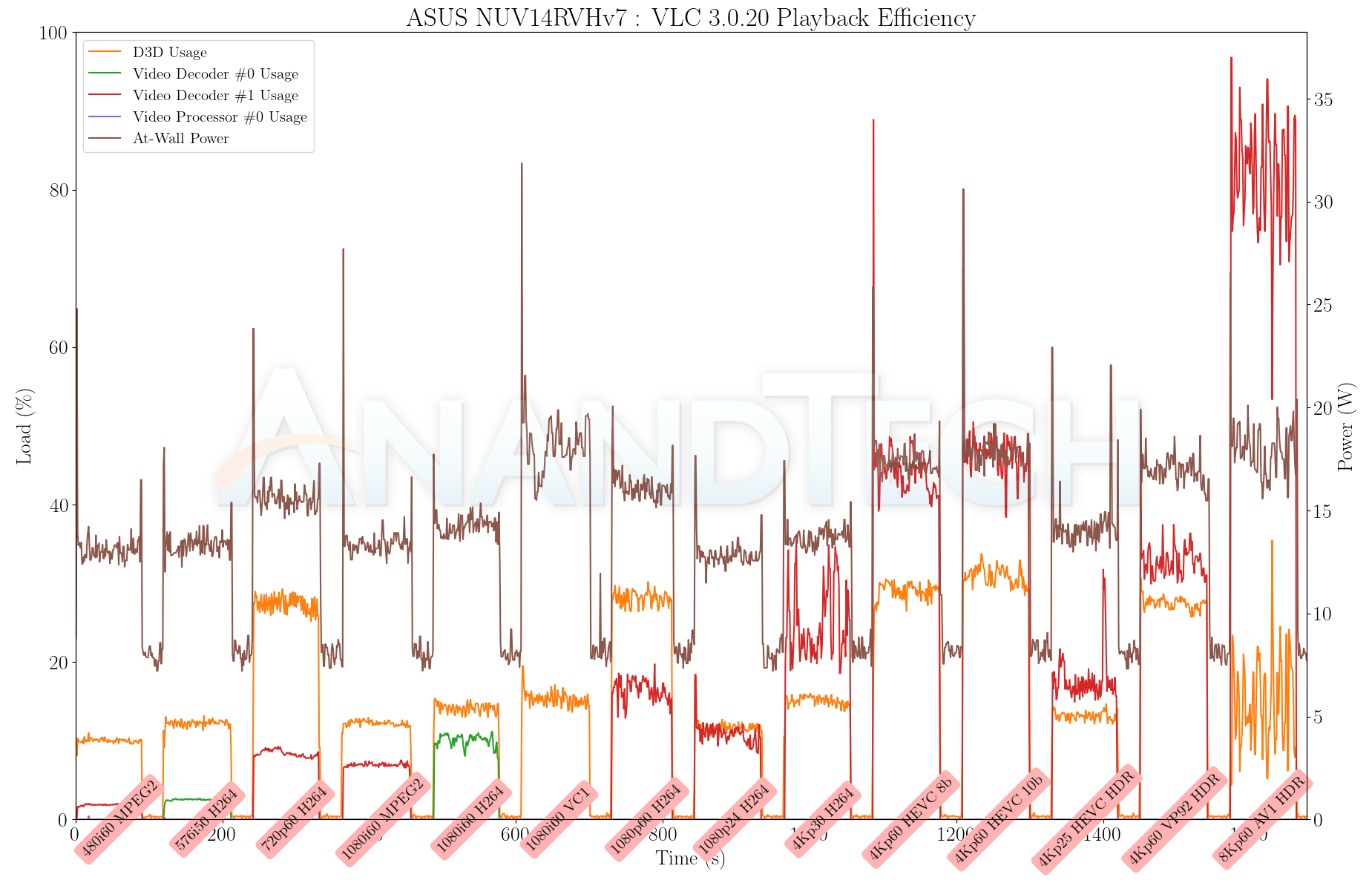
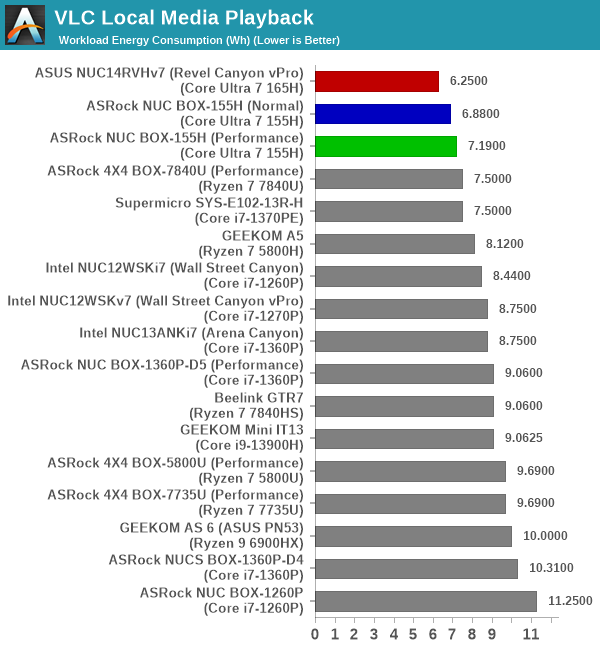
Restricting the decoding and rendering activity to the SoC tile helps in keeping the energy consumption numbers low.
| Kodi 21.0 Playback Efficiency | |||
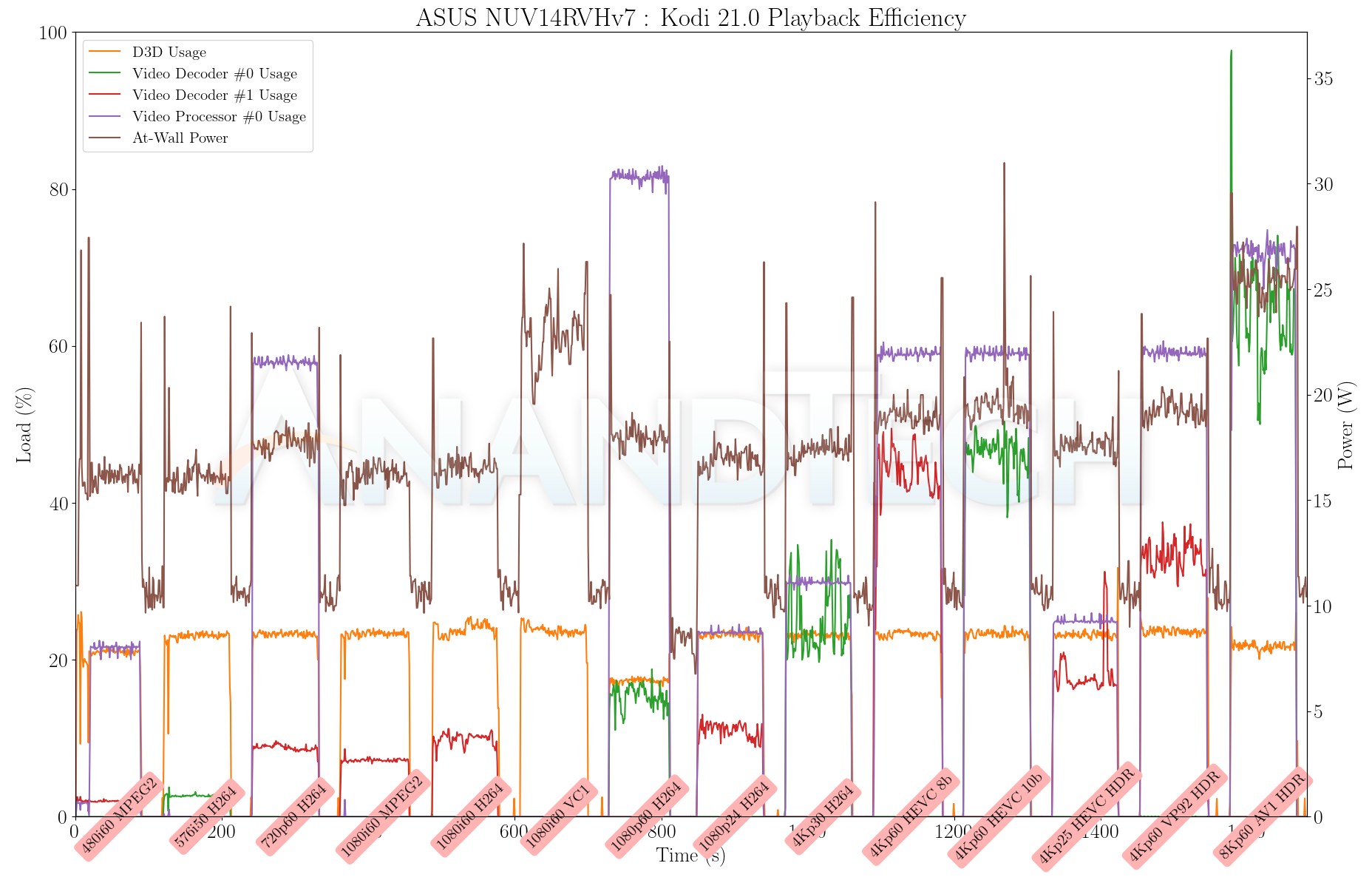

There is increased GPU activity with the Kodi interface in the picture. This results in a bit of an energy consumption penalty, but the numbers are still good enough to keep the three MTL-H configurations in the upper half of the pack.
| mpv 0.38.2 (Default) Playback Efficiency | |||
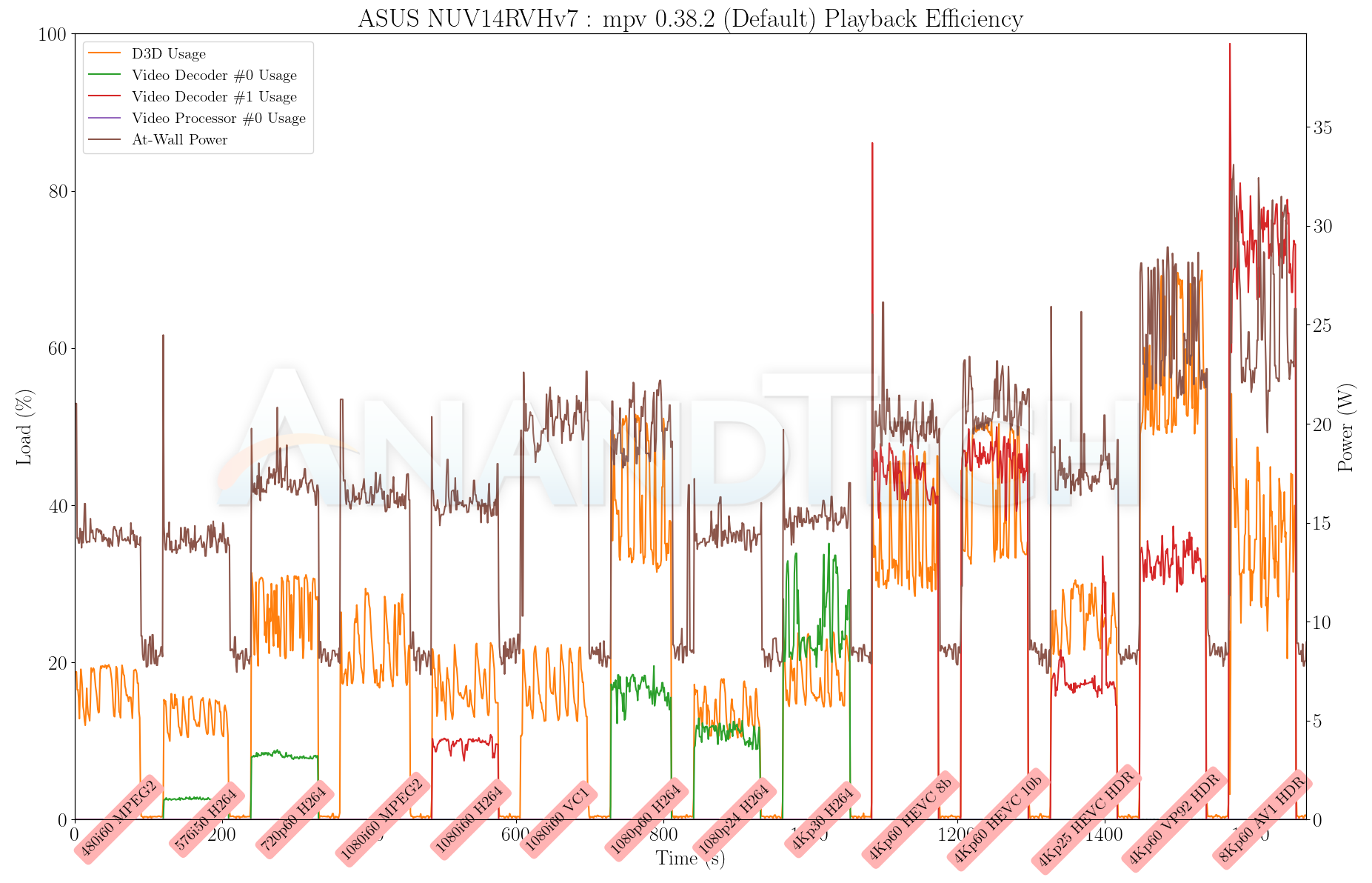

| mpv 0.38.2 (GPU-HQ) Playback Efficiency | |||
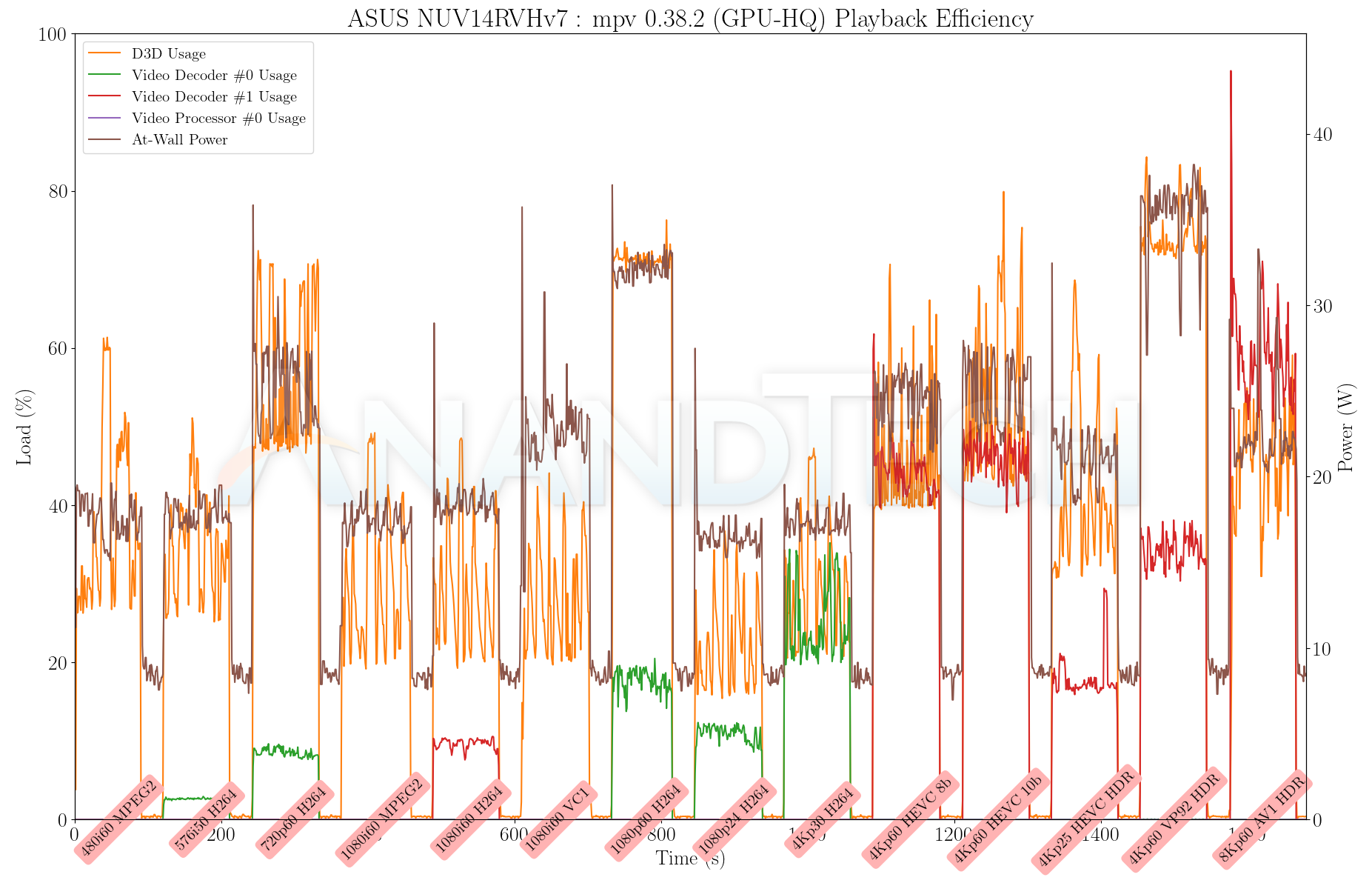
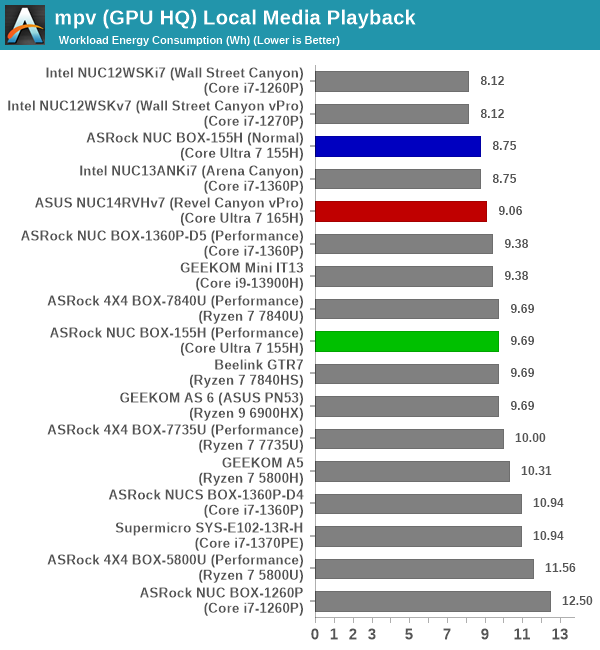
Both mpv configurations require increased communication between the GPU tile and the SoC tile because of the shader-based post-processing. This naturally increases the energy consumption numbers, and pushes the Meteor Lake systems to the middle of the pack.
The power consumption at the wall was measured with a 4K display being driven through the HDMI port of the system. In the graph below, we compare the idle and load power of the ASUS NUC14RVHv7 (Revel Canyon vPro) and ASRock Industrial NUC BOX-155H in both normal and performance modes with other systems evaluated before. For load power consumption, we ran the AIDA64 System Stability Test with various stress components, as well as our custom stress test with Prime95 / Furmark, and noted the peak as well as idling power consumption at the wall.
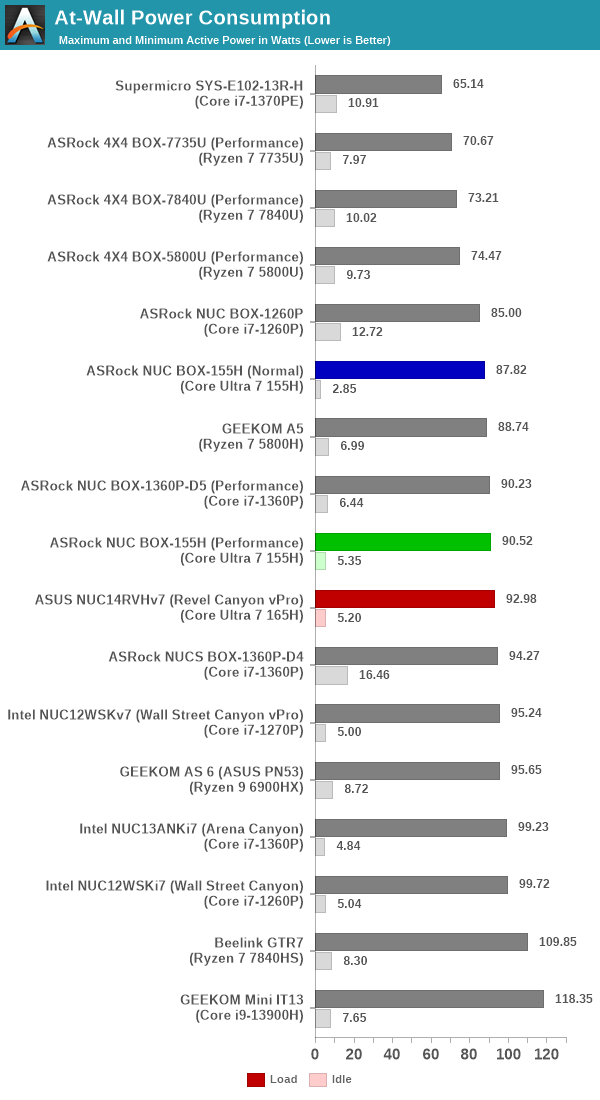
The numbers are consistent with the TDP and suggested PL1 / PL2 values for the processors in the systems, and do not come as any surprise. With a 64W for the PL2 setting, we see the peak power consumption of the MTL-H systems to be around 90W.
Stress Testing
Our thermal stress routine is a combination of Prime95, Furmark, and Finalwire’s AIDA64 System Stability Test. The following 9-step sequence is followed, starting with the system at idle:
- Start with the Prime95 stress test configured for maximum power consumption
- After 30 minutes, add Furmark GPU stress workload
- After 30 minutes, terminate the Prime95 workload
- After 30 minutes, terminate the Furmark workload and let the system idle
- After 30 minutes of idling, start the AIDA64 System Stress Test (SST) with CPU, caches, and RAM activated
- After 30 minutes, terminate the previous AIDA64 SST and start a new one with the GPU, CPU, caches, and RAM activated
- After 30 minutes, terminate the previous AIDA64 SST and start a new one with only the GPU activated
- After 30 minutes, terminate the previous AIDA64 SST and start a new one with the CPU, GPU, caches, RAM, and SSD activated
- After 30 minutes, terminate the AIDA64 SST and let the system idle for 30 minutes
Traditionally, this test used to record the clock frequencies – however, with the increasing number of cores in modern processors and fine-grained clock control, frequency information makes the graphs cluttered and doesn’t contribute much to understanding the thermal performance of the system. The focus is now on the power consumption and temperature profiles to determine if throttling is in play.
ASUS NUC14RVHv7 (Revel Canyon vPro)
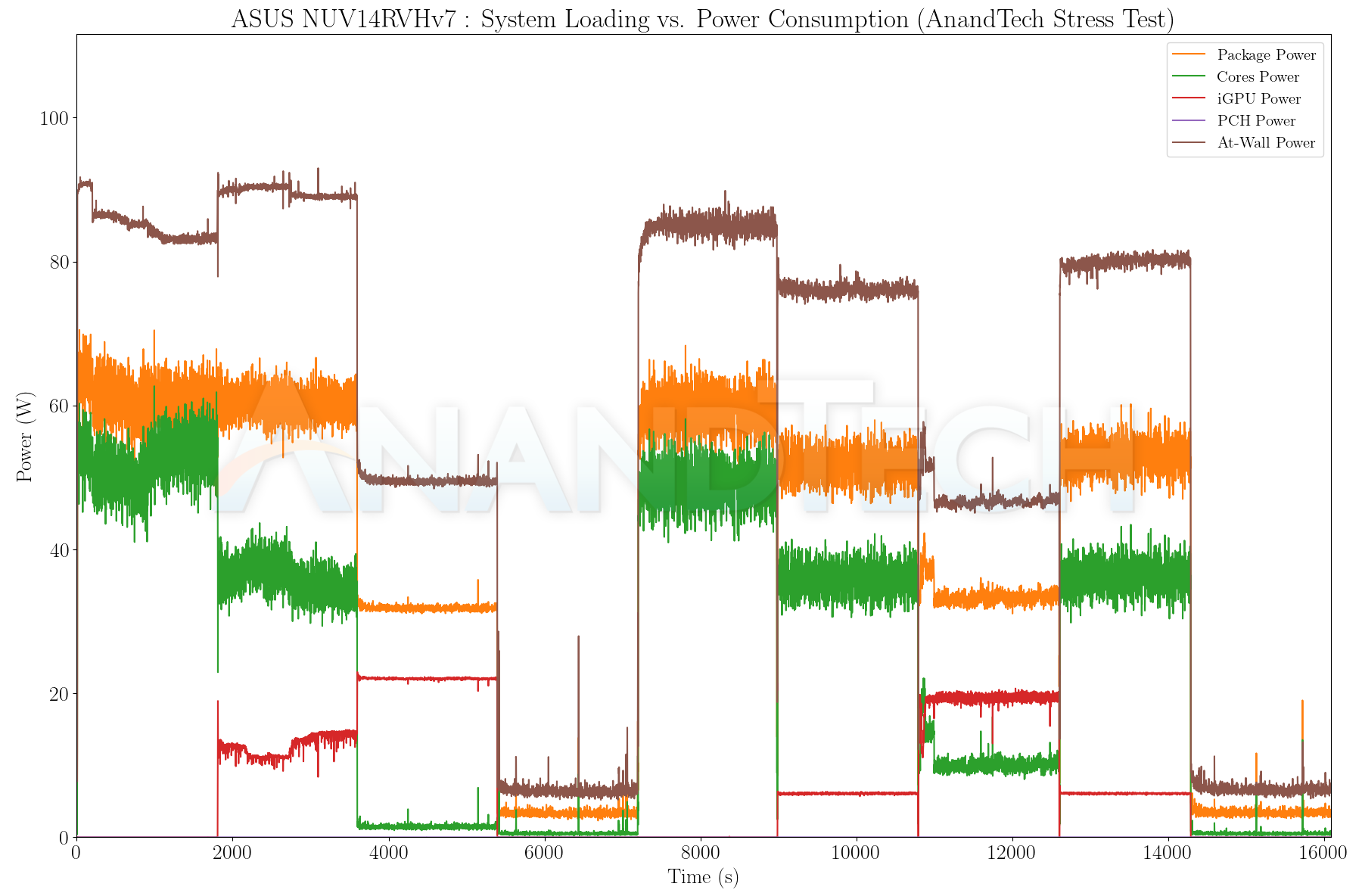
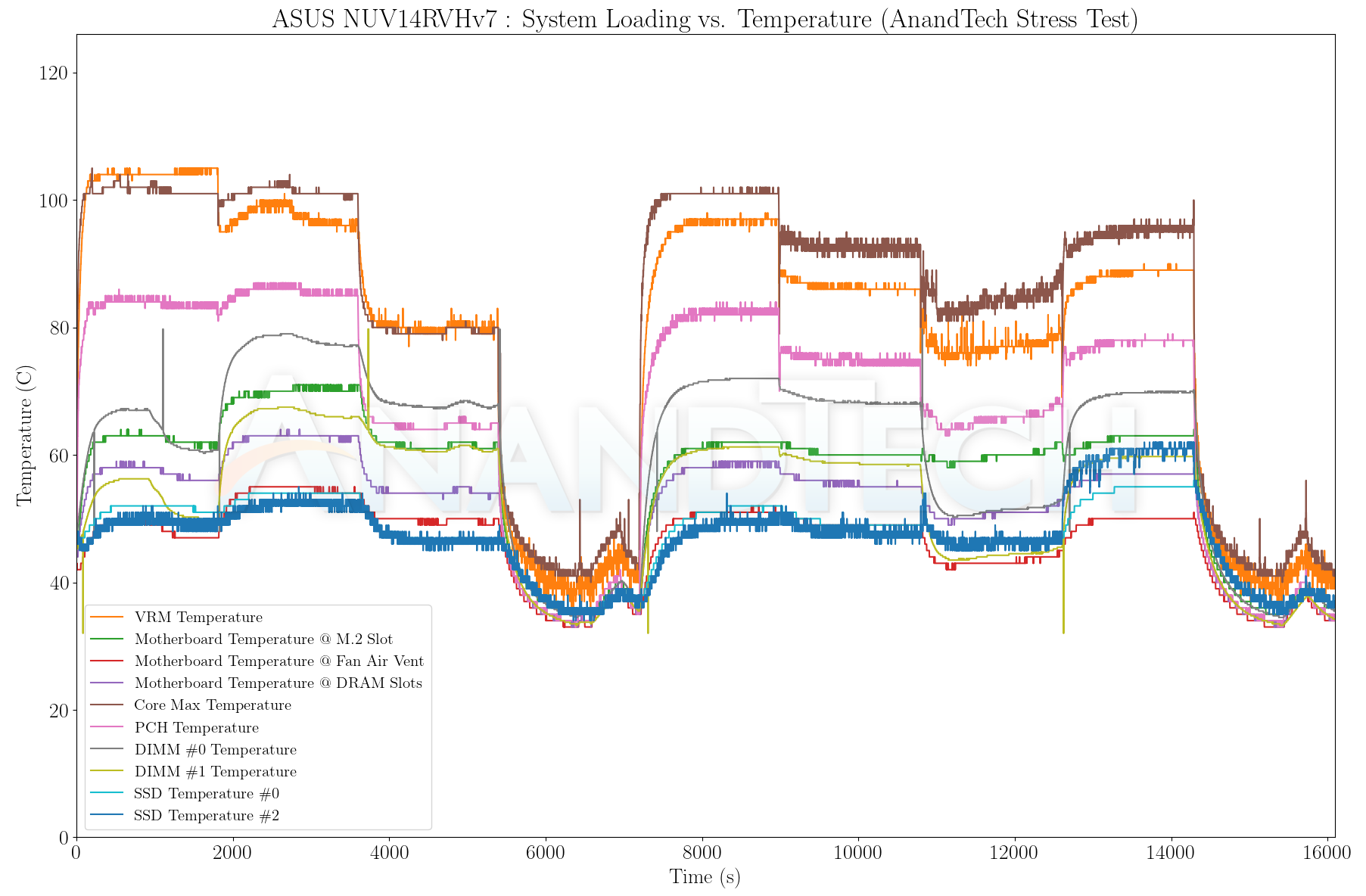
The dynamic PL1 of 64W ensures that the package power stays around that mark all through the segments where the CPU is stressed. The downside is that the temperatures of different components such as the VRMs and the cores consistently stay near 100 C. This doesn’t seem like a good thing from a reliability perspective, but ASUS does claim a MTTF of more than 50K hours (based on running a stress test with 100% fan speeds for 90 days in a 40C environment). On the SSD and DRAM side, things look a lot better – the SSD goes up to 60C under stress and the SODIMMs up to 70C. The copper block with thermal pads helps the former keep its cool.
ASRock Industrial NUC BOX-155H (Normal Mode)
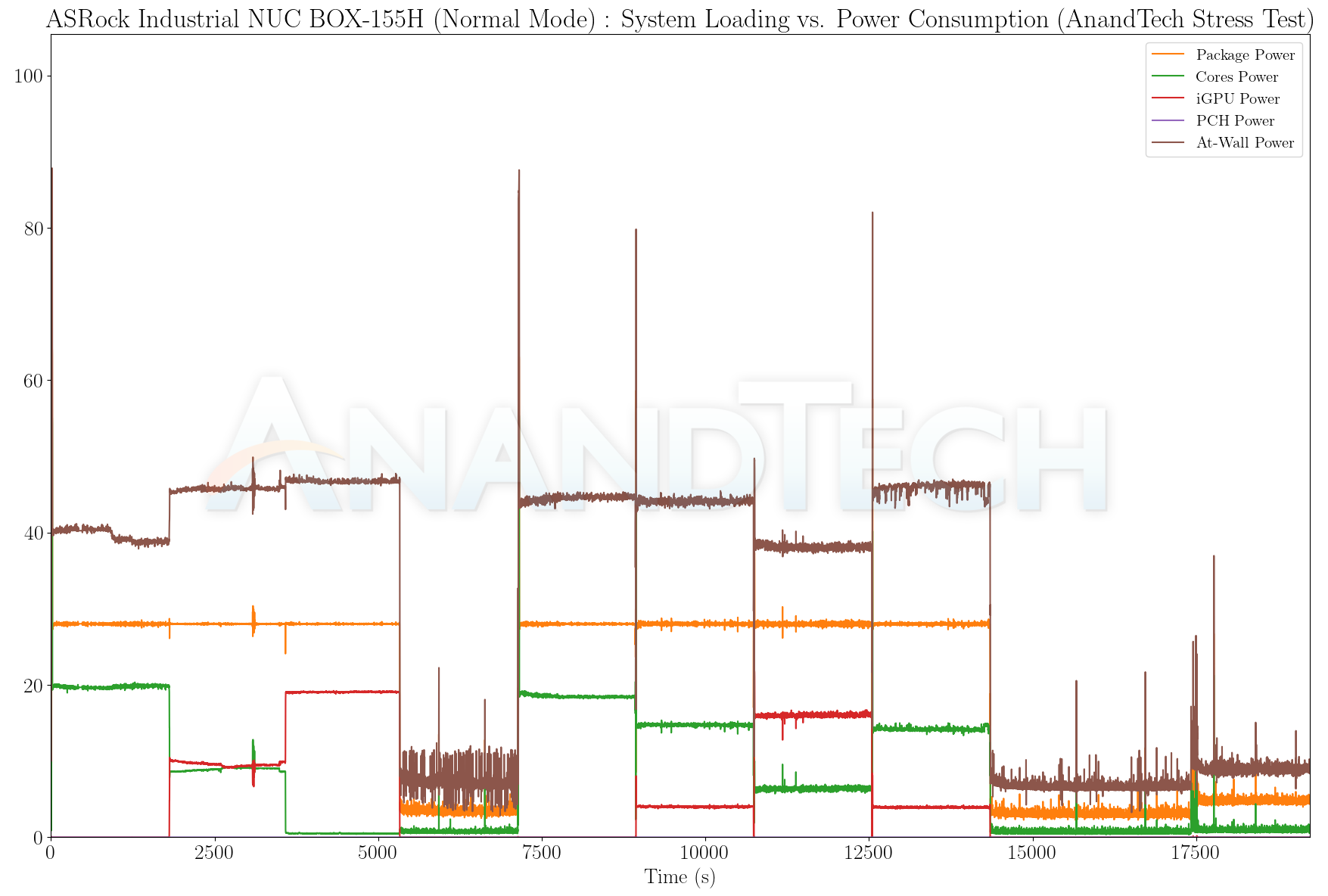
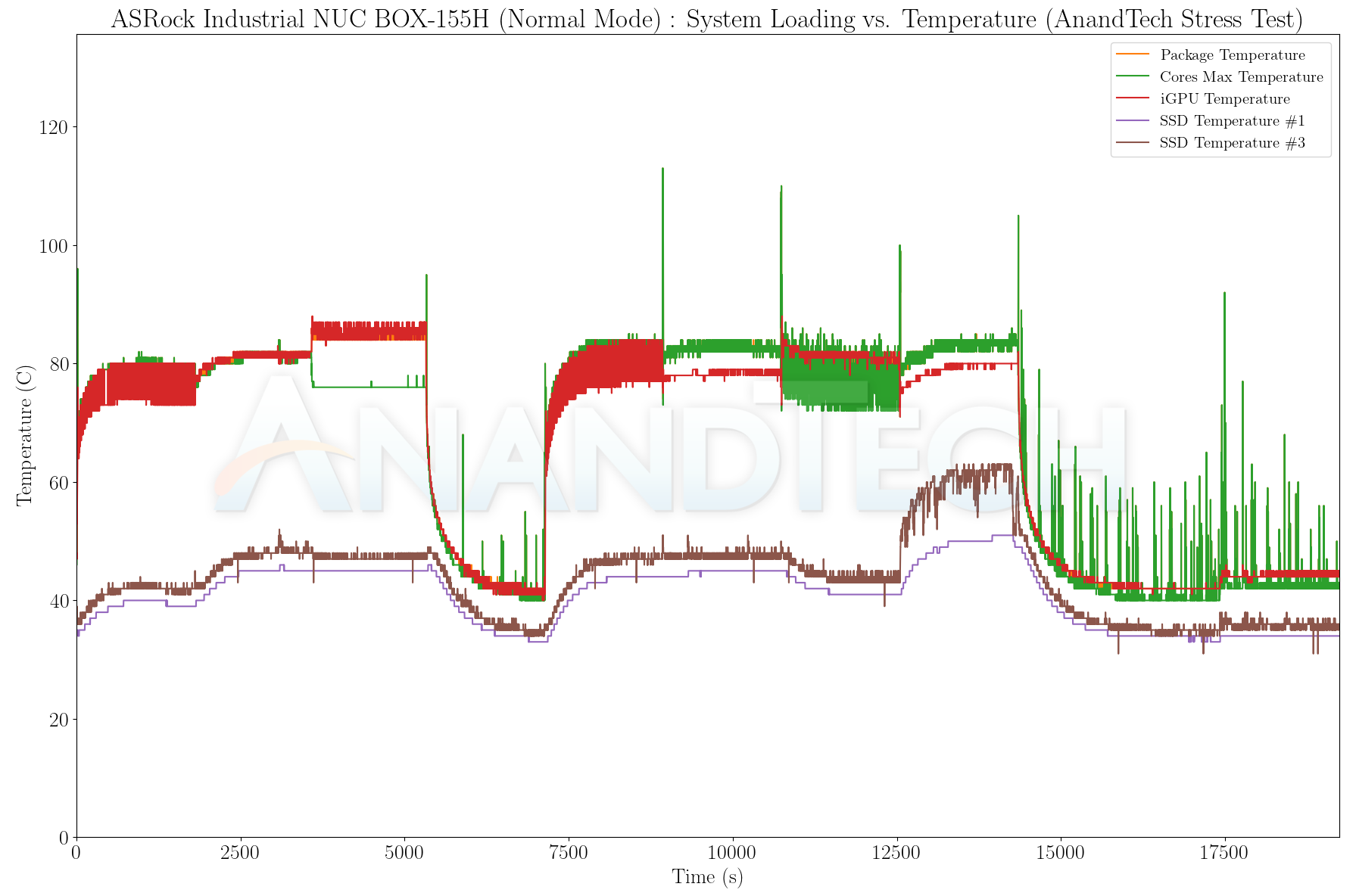
The NUC BOX-155H adopts a more tried and tested 28W configuration for the package power in the normal mode. The core temperature is consistently below 85C (except during the PL2 spikes). The SSD doesn’t cross 60C during its stress segment, thanks to the effective thermal solution.
ASRock Industrial NUC BOX-155H (Performance Mode)
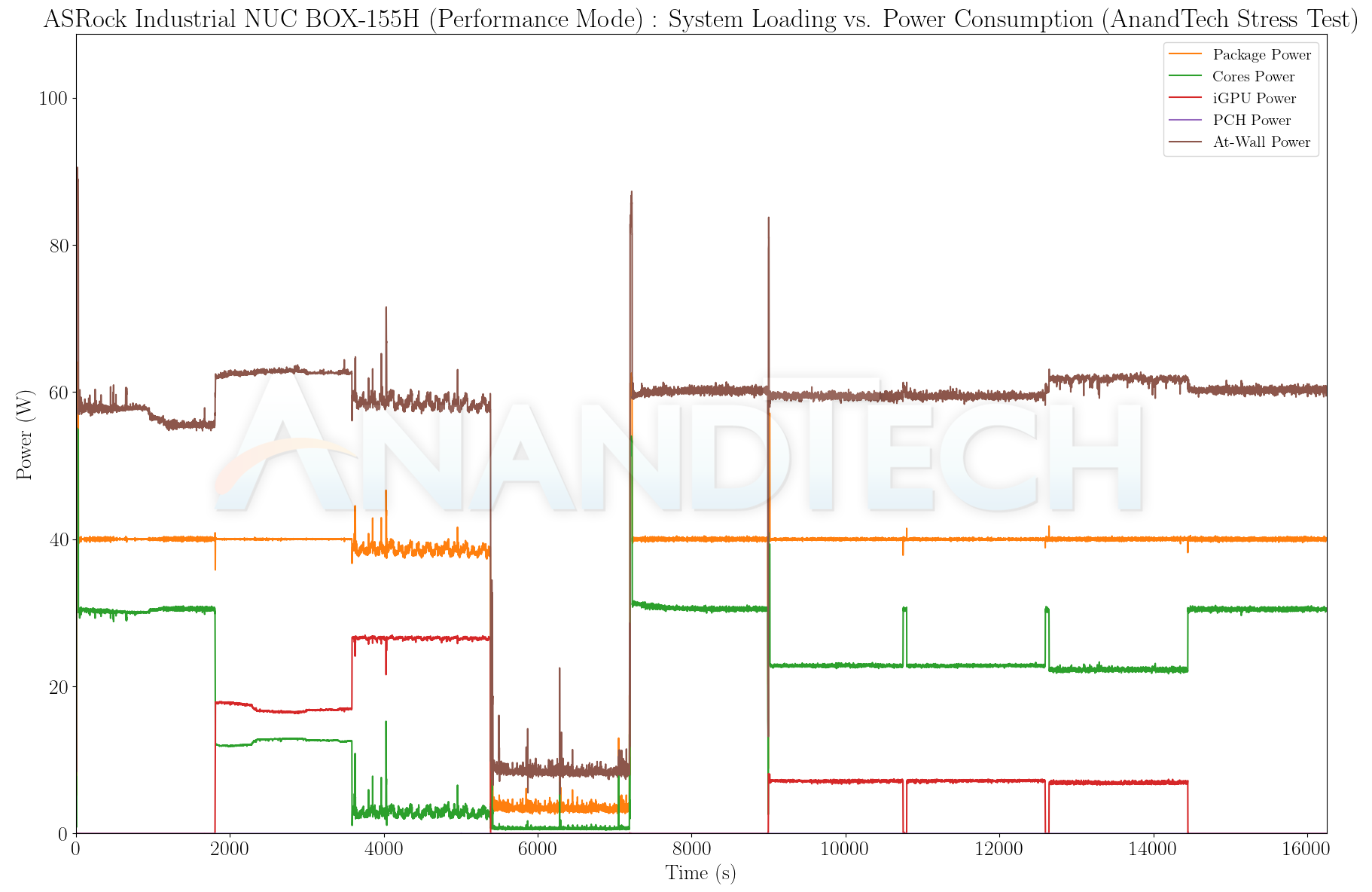
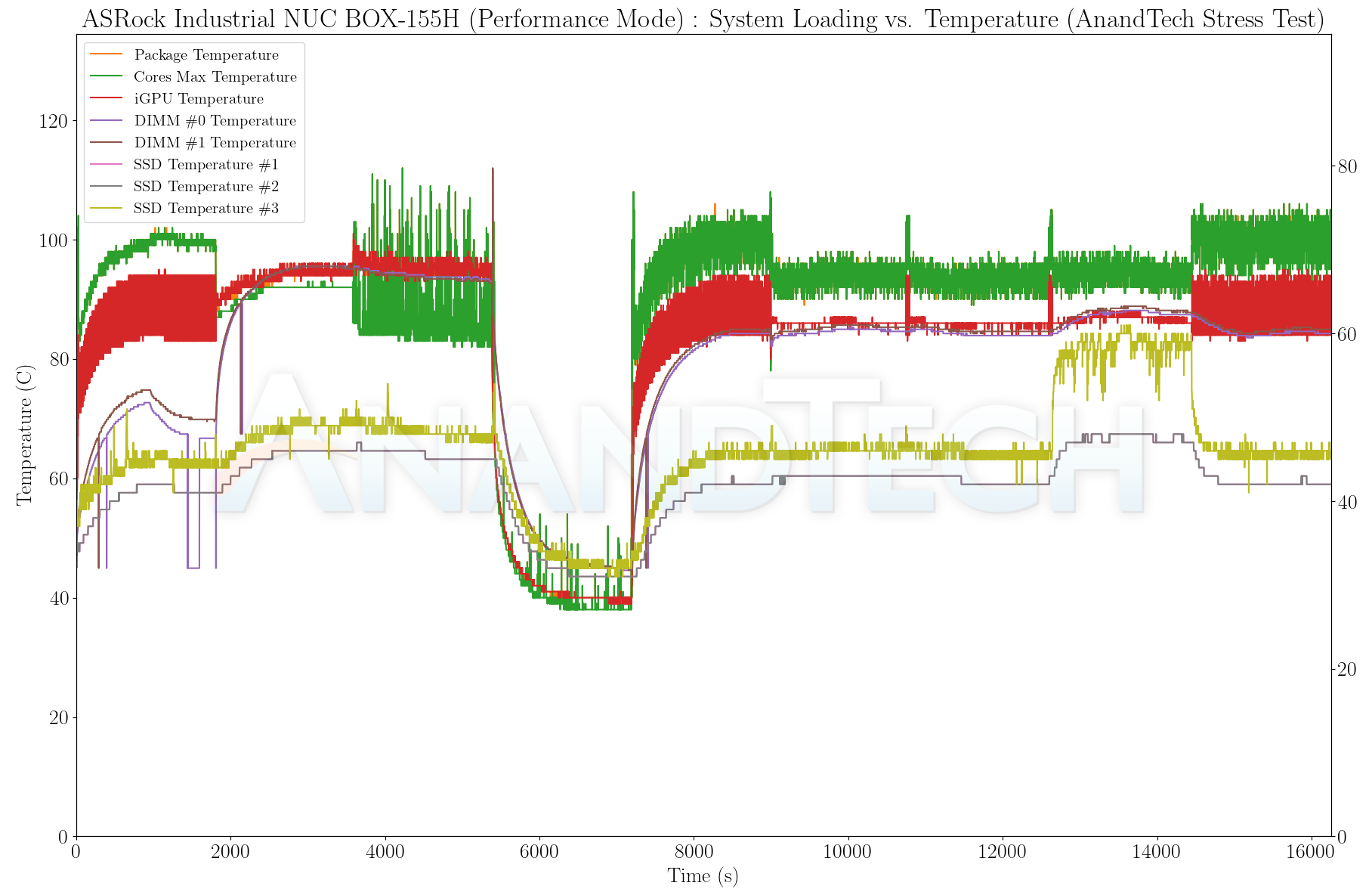
A 40W PL1 is adopted and maintained in the performance mode at the cost of running the fan at full tilt throughout. The core temperature does reach and saturate around 100C during stress segments, which again brings up reliability concerns under sustained stress scenarios.
Networking and storage are aspects that may be of vital importance in specific PC use-cases. The ASRock Industrial NUC BOX-155H comes with dual LAN ports backed by Intel NBASE-T controllers (up to 2.5 GbE). On the other hand, the ASUS NUC14RVHv7 has only one 2.5GbE LAN port. This is a definite plus point for the NUC BOX-155H when it comes to specific networking use-cases. The Wi-Fi support in both systems is similar – 2T2R 802.11ax (Wi-Fi 6E) with 160 MHz channels using the Intel AX211 WLAN module.
On the storage side, different versions of the Samsung SSD 990 PRO were used in the two systems. While our own 2TB sample of the 990 PRO was placed in the NUC BOX-155H, ASUS supplied the 512GB OEM version of the SSD (PM9A1a) for the NUC14RVHv7. In both systems, the SSDs connect via a PCIe 4.0 x4 link. From a benchmarking perspective, we provide results from the WPCstorage test of SPECworkstation 3.1. This benchmark replays access traces from various programs used in different verticals and compares the score against the one obtained with a 2017 SanDisk 512GB SATA SSD in the SPECworkstation 3.1 reference system.
| SPECworkstation 3.1.0 – WPCstorage SPEC Ratio Scores | |||
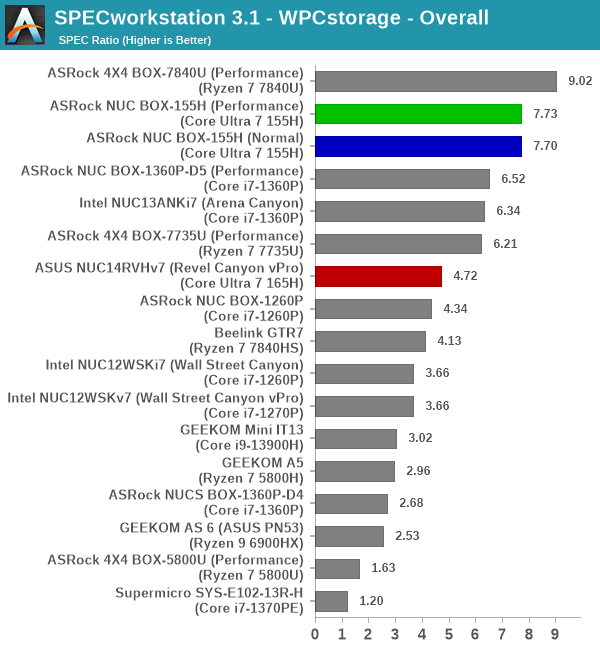
The graphs above present results for different verticals, as grouped by SPECworkstation 3.1. The storage workload consists of 60 subtests. Access traces from CFD solvers and programs such as Catia, Creo, and Soidworks come under ‘Product Development’. Storage access traces from the NAMD and LAMMPS molecular dynamics simulator are under the ‘Life Sciences’ category. ‘General Operations’ includes access traces from 7-Zip and Mozilla programs. The ‘Energy’ category replays traces from the energy-02 SPECviewperf workload. The ‘Media and Entertainment’ vertical includes Handbrake, Maya, and 3dsmax.
The NUC14RVHv7 is hampered in the above tests by its low capacity point. On the other hand, the SSD 990 PRO finds itself in the top half with similar scores in both operating modes of the NUC BOX-155H. Surprisingly, the same SSD in the Phoenix-based 4X4 BOX-7840U scores better overall. This points to the CPU being a bottleneck – likely due to the allocation of some benchmark segments to the efficiency cores.
Closing Thoughts
The ASUS NUC14RVHv7 (Revel Canyon vPro) and the ASRock Industrial NUC BOX-155H provided us with the opportunity to evaluate the Meteor Lake-H platform in an ultra-compact desktop. This form-factor allows vendors much more leeway in terms of configuring the power limits. While Meteor Lake was introduced primarily for notebooks, ASUS and ASRock Industrial have shown that the capabilities can be marketed effectively even in the desktop space.
On the technical front, Meteor Lake is undoubtedly an impressive product family with its chiplet / tile-based architecture allowing for a mixture of dies fabricated in different processes. The disaggregation of different functions brings about energy and power savings for specific tasks such as media playback. The integration of an NPU (the Movidius VPU3720) enables acceleration of different neural networks and AI applications. Intel and its partners have realized that these continue to remain in the domain of developers and advanced users for now. In a bid to open them up to the mass market, sample applications are being developed using Intel’s customized models for different computer vision tasks. ASRock Industrial is offering the AI Guru software pack as a free download as part of this endeavor.
While this type of AI push is welcome, mass market adoption is going to be completely reliant on real-world use-cases such as querying of private photo albums, or automatic indexing and querying of videos from network cameras, and other such applications. It will take a few more years for these types of applications to become pervasive, and at that time, a performant NPU would become a must-have. As it stands currently, the NPU is good to have, but there aren’t too many real-world use-cases to take advantage of it.
Between the NUC14RVHv7 and the NUC BOX-155H, the 64W dynamic PL1 setting of the former gives it the edge in many of the CPU-centric workloads. On the other hand, the NUC BOX-155H, particularly in its 40W version, consistently outperforms the NUC14RVHv7 in GPU-heavy workloads. The former has an extra Thunderbolt port, while the latter has an extra 2.5 GbE port. The NUC14RVHv7 has some nifty features such as display emulation that do not have a corresponding equivalent in the NUC BOX-155H. Based on the specific requirements and use-cases, either Meteor Lake-H system is a good choice. At $700, the NUC BOX-155H maintains the launch pricing of previous flagship NUC BOX products from ASRock Industrial.
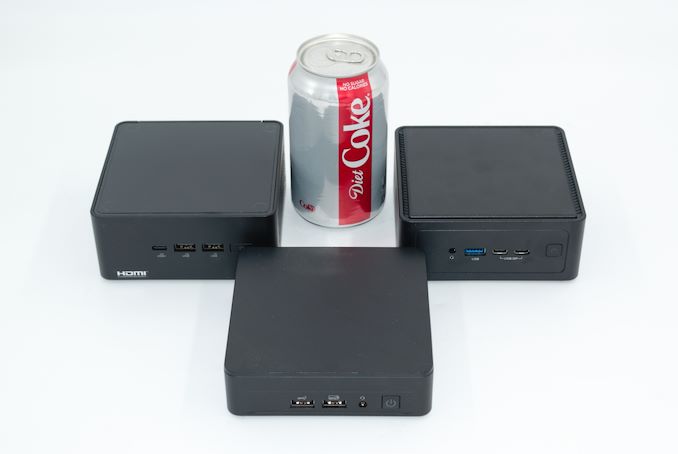
[ Top-Left: ASUS NUC14RVHv7 (Revel Canyon vPro), Top-Right: ASRock Industrial NUC BOX-155H, Center: Intel NUC13ANKi7 (Arena Canyon) ]
Positives aside, readers might have noticed that SPECworkstation 3.1 results were not presented for any of the MTL-H systems. Unfortunately, the Arc GPU drives have a hard freeze / hang issue with the Folding @ Home component of the benchmark. Intel is currently looking into the problem and hopes to have a fix out soon. We also faced problems with applications such as DXVAChecker.
The other disappointing aspect is the regression in performance for many real-world workloads compared to UCFF systems based on Raptor Lake-P. The reasons for that are not immediately obvious – whether it is due to the ‘Thread Director’ implementation in Windows 11 23H2, or it is due to the distribution of some of the CPU cores across different tiles, or due to comparatively low CPU clock speeds. The surprising aspect is that the NUC14RVHv7, despite its sustained 64W power budget, comes up short against the Arena Canyon NUC13ANKi7 with a 40W power budget in benchmarks such as the UL Procyon Office Workload.
Raptor Lake-P-based systems might not boast of a dedicated NPU or a fancy chiplet architecture with power and energy savings for specific tasks. However, they deliver more consistent performance and have much more stable iGPU drivers compared to Meteor Lake. As it stands currently, a Meteor Lake-based UCFF desktop is recommended only for power users who can put up with performance quirks and possible driver issues. Raptor Lake and Phoenix-based systems are currently better choices for the average consumer.
